The Water Horse: Legend of the Deep (PG)
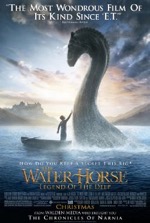
Starring: Emily Watson
December 2007
“A Water Horse and His Boy”
From Disney and Walden Media, who brought us The Chronicles of Narnia, comes The Water Horse, a heart-warming origins tale of how the Loch Ness Monster—or water horse—came into being and why all knowledge of this mythical sea creature has been lost. The film is based on Dick King-Smith’s children’s novel of the same name.
The movie opens in a Scottish pub where an old man (Brian Cox) tells a young couple the “true” story of the water horse. His tale begins with young Angus MacMorrow (Alex Etel) discovering a watermelon-shaped egg on a shell-hunting expedition in the loch near his family’s manor. The egg soon hatches and produces a baby water horse (if you’ve ever studied dinosaurs, the little beastie looks similar to the plesiosaur). Angus does his best to raise the affable animal, which he nicknames Crusoe, but it becomes evident within a matter of days that the toilet bowl, bathtub and outdoor fountain won’t be able to contain the rapidly growing creature for much longer. This, of course, presents a big problem for Angus, who wants to keep Crusoe as a pet but finds it increasingly difficult to hide the water horse from his mother.
The Water Horse offers quite a bit more than what it revealed in its family friendly trailer, which painted the film in pre-teen hues. There’s a subplot involving a Scottish regiment setting up a base of operations near the loch. Besides providing a context for the film (1942 in war-torn Britain), this story element balances the more pedestrian moments with mature themes like war and death, topics Alex is confronted with every day as he awaits his father’s return from the front lines. Another adult storyline focuses on mysterious handyman, Mowbray (Ben Chaplin), who haplessly stumbles into a love triangle with Angus’ widowed mother, Anne (Emily Watson) and the starchy Capt. Thomas Hamilton (David Morrissey).
The film’s cinematography is superb; effectively incorporating backgrounds from the extensive on-location shoots in New Zealand and Scotland, the movie boasts spectacular panoramic views of the loch and its surrounding mountains. The CG rendering of the creature—forged in LOTR’s Weta Workshop—is first-rate. The water horse-back riding scene, where Angus is forced to confront his fear of water, is the creative and emotional apex of the film and is sure to thrill audience members of all ages.
Despite borrowing liberally from movies like E.T., Free Willy and Eragon, The Water Horse is a charming tale of courage, compassion and friendship. The concluding scene opens the door for a possible sequel, but whether or not a follow-up is forthcoming, The Water Horse has already proven that it’s much more than just a one trick pony.
Rating: 3
Juno (PG-13)
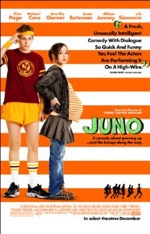
Starring: Ellen Page
December 2007
“Well-written Script Makes For a Well-rounded Drama”
Young Juno McGuff (Ellen Page) nervously paces back and forth in her living room as her expectant parents wait with bated breath for Juno’s announcement—they think she’s been expelled from school. Expulsion, a word Juno employs as if she learned it on a flashcard in the womb, is the least of her parents’ worries. As tension builds, Juno summons enough courage to exhale those two words that every parent of a teenage daughter fears to hear, “I’m pregnant.” Shell-shocked, her parents launch into a series of contingency plans—prenatal vitamins, etc.—and then wryly ask themselves why it couldn’t have been something simpler…like drugs.
Thus begins the indie dramedy of precocious teens and world-weary adults. The movie has many subtle messages woven into its seemingly innocuous narrative. Issues like teenage pregnancy—and by extension abortion vs. adoption—and marital (in)fidelity are all handled with relative ease by screenwriting newcomer, Diablo Cody, a former exotic dancer. My only criticism of Cody’s work is that the dialogue she puts in Juno’s mouth—laced with SAT words, modern expressions and enough societal references to fill a dictionary of cultural literacy—seems a little too advanced for a sixteen-year old girl. That’s not to say that teens like Juno don’t exist, but exactly what percentile are we talking about? Still, it’s nice to see a movie that exemplifies a young person who is intelligent and well-adjusted…imagine a society in which Juno was an average teenager!
Besides the groundbreaking performance by Page, some wonderful supporting performances are turned in by the eclectic ensemble. Allison Janney and J.K. Simmons play disappointed but supportive parents who handle Juno’s indiscretion with a surprising degree of equanimity. Simmons, in particular, brings charm, humor and sagacity to his part. There’s a great father/daughter scene, where Simmons’ character tries giving Juno advice, that’s amusing in its awkwardness and touching in its genuineness.
Jason Bateman and Jennifer Garner play the young couple who desperately want to adopt Juno’s baby; they discover the knocked up teen’s ad in the Penny Saver paper. Bateman and Garner are pitch-perfect in the film’s most complex roles; Garner is delightfully understated and Bateman is a portrait of ambivalence in a marriage riddled with relational subtext.
Director Jason Reitman (Ivan’s son), equipped with a superlative script and excellent performances, has helmed an effort that’s shifted the paradigm for teen angst pictures. You can bet this original storyline, masterfully executed and promulgated by Reitman, Cody and Paige, will be emulated without success for years to come, ad nauseam. But for now, enjoy the blissfully sweet beginnings of a new movement in film.
Rating: 3
National Treasure: Book of Secrets (PG)
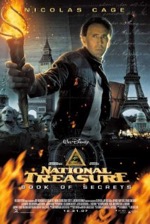
Starring: Nicolas Cage
December 2007
“Gates Works Harder, Gets Richer in Globetrotting Sequel”
The sequel to 2004’s National Treasure is subtitled, Book of Secrets. The titular book is a rumored collection of top-secret articles and accounts for the president’s eyes only. Ben Gates (Nicholas Cage) and his father, Patrick (Jon Voight), follow a series of clues that lead them on a frenetic steeplechase through France, London and Washington, D.C. Once discovered, the book offers additional clues that direct the Gates’ plus sidekicks, Abigail Chase (Diane Kruger) and Riley Poole (Justin Bartha) along with antagonist, Mitch Wilkinson (Ed Harris) to Mt. Rushmore where the discovery of a secret treasure will clear the Gates family name (something about Ben’s great-grandfather allegedly being a co-conspirator in Lincoln’s assassination).
I won’t go into too much detail about the cohesive yet scattershot plot, but I will say that NT2 is every bit as good as the original and perhaps a tad better. NT2 has a broader canvas than the original; besides adding European destinations to the itinerary, the film also introduces some new characters and features a more elaborate treasure hunt.
The finest new addition to the cast is Helen Mirren as Ben’s mother, Prof. Emily Appleton. Patrick and Emily, who were separated a number of years ago, are reunited out of necessity; seeing them thrown back into the mix together is actually the most enjoyable aspect of the film. Ben and Abigail’s relationship has also hit the skids and whereas some of their vehement interactions are amusing, the relational discord just didn’t work for me as well as Ben’s bickering parents. But in light of this nation’s alarming divorce rate (and Hollywood’s even worse track record), it’s refreshing to see couples working out their differences instead of just giving up…a very positive example, especially for the younger, more impressionable, segment of the audience.
As with the first National Treasure, viewers are required to suspend their disbelief to staggering heights and buy into conspiracy theories based on some facts with a ton of supposition and wild leaps of logic to spare. Out of all the head-scratching elements in the film, the one I just couldn’t abide is the scene where Ben abducts the president (Bruce Greenwood)…like it could possibly be that easy. However, all’s well that ends well as the prez. later exonerates Gates of any wrongdoing…I’m sure it had a lot to do with Ben finding the national treasure which will help pay off the national debt.
So, what did Ben see on page forty-seven of the Book of Secrets? If the box office is favorable for NT2, we might only have a couple years to find out. Otherwise, that secret knowledge might end up buried in the past.
Rating: 2 1/2
I Am Legend (PG-13)

Starring: Will Smith
December 2007
“We Have Seen the Enemy and It is Us!”
Based on Richard Matheson’s novel of the same name, published in 1954, I Am Legend is the third filmic adaptation of his dark, dystopian yarn (1964’s The Last Man on Earth and 1971’s The Omega Man). Though the film diverges from Matheson’s novel in a few key areas, most notably the resolution, this I Am Legend retains the book’s melancholy tone and macabre themes while giving the story a modern upgrade.
The movie takes place in 2012, three years after a virus (engineered to cure cancer) turns airborne and eradicates 5.4 billion people, effectively transforming NYC into a weed-infested wildlife preserve. Col. Robert Neville (Will Smith) has natural immunization to the virus and tries to unravel what went wrong with the supposed miracle cure. His day consists of pilfering supplies from abandoned apartments, hunting deer with his dog, Sam, and working in his lab to find a cure for the virus. At dusk, Robert boards up his apartment, turns off all the lights and curls up with Sam and his rifle in the bathtub. The shrieking screams of “the creatures” who roam the streets at night plague Robert’s fitful sleep as he shivers in fear and prays for the dawn.
Besides merely scaring the audience senseless (which it does with all the subtlety of an exploding bomb), I Am Legend is also disturbing on deeper, more salient levels, not the least of which is the scientific plausibility of a designer virus, however well-intentioned in its application, actually wiping out our entire species. It’s conceivable that our scientists could do it in haste—or by accident. Jeff Goldblum’s indicting line in Jurassic Park, “…your scientists were so preoccupied with whether or not they could, they didn't stop to think if they should,” readily comes to mind here. And what about radical terrorists who would resort to germ warfare to defeat their enemies? As terrifying as the movie’s “dark seekers” are, these shocking scenarios are far more unsettling.
One of the rules for crafting any good piece of fiction is “Show, don’t tell.” Director Francis Lawrence (a former pop-video creator), expertly adheres to that maxim while forging Matheson’s brainchild and Mark Protosevich and Akiva Goldsman’s adapted screenplay into his own frightening vision of our world gone horribly wrong. As we closely study Robert’s actions, questions naturally arise, like: Why does Robert have the alarm on his wristwatch set to go off at different times during the day? What is the significance of the various appearances of butterflies in the film? Who set the trap that snares Robert, and why does he fall for it? And, does the mannequin’s head turn or is it just a motion-created optical illusion? Or was that just my imagination?
“Because there is so little dialogue,” Smith told EW, “every moment has to be rich with human experience.” Ergo, I Am Legend can be viewed as a kind of near-future Cast Away, with the main differences being location (distant island vs. devastated metropolis), sidekicks (blood-painted volleyball vs. intrepid German Shepherd) and stars (Hanks vs. Smith). At first glance, Smith would seem to be no match for Hanks, but Smith’s acting here is amply textured and cleverly nuanced. In his most ambitious role to date, Smith plays a man in the throes of loneliness who hangs onto sanity by a thread; a physically and psychologically demanding performance that, in its own way, rivals his career-defining turn in The Pursuit of Happyness—the gold standard for Smith films.
I Am Legend has great atmosphere during the day (thanks in large part to the keen eye of LOTR’s cinematographer, Andrew Lesnie), but the night scenes feel like a glorified zombie movie, however intense. The movie’s most riveting sequences take place during daylight hours—Robert chases Sam into an abandoned warehouse and Robert confronts mannequin, Fred, who’s moved during the night. The special effects are also a mixed bag—the CGI is quite good early on, but as the movie progresses the visuals get hokier (did they run out of F/X funds?), particularly on the dark seekers, whose half-baked appearance and movements resemble an average video game character.
Despite these niggling details, I Am Legend is an exhilarating thrill-ride that features spine-tingling encounters, pulse-pounding pursuits and disturbing revelations about the human condition under extreme conditions. With its eerily realistic shots of nature reclaiming Times Square, engaging flashbacks, Oscar-caliber lead acting and heart-stopping action scenes; I Am Legend has set the bar for near-future outbreak films to near-unattainable heights. If the movie’s done its job, it will haunt you with its horrific “what if” scenario long after you’ve left the theater: lingering side effects may include anxiety, paranoia or excessive jumpiness. You’ve been sufficiently forewarned!
Rating: 4
The Golden Compass (PG-13)
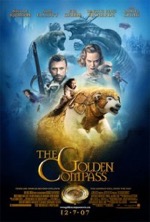
Starring: Nicole Kidman
December 2007
“Gobblers and Witches and Bears…Oh, My!”
So what’s the big deal? Where’s the justification for all of the controversy? After hearing, ad nauseum, about the purportedly anti-God, anti-Catholic church themes in Philip Pullman’s novel-turned-movie the last few months, I just don’t see it. Sure there’s the whole communicating with spirits thing…and I suppose it doesn’t help that those animal companions are called daemons. Then there’s the Magisterium, the controlling body of monks, friars and priests, some of whom conspire in dark shadows like the Cigarette Man and his gang in the X-Files; but this certainly isn’t the first secret society ever to plot and scheme in the shady corner of a big screen, and just because many of them carry on like Jesuits doesn’t actually mean they are. After all, this is a fantasy world so we can suspend our disbelief, right?
The Golden Compass, the first book in Pullman’s His Dark Materials trilogy, features children far less adept at magic than those in the Harry Potter movies and a storyline far less epic than the one employed in Peter Jackson’s The Lord of the Rings trilogy. It’s commonly accepted that every fantasy story written since The Lord of the Rings trilogy has implemented, to some degree or dimension, J.R.R. Tolkien’s tropes, themes and iconography—the foundational elements for what we now refer to as fantasy fiction. Although certainly no exception to this assertion, Compass has blended the notable works of Tolkien, C.S. Lewis, J.K. Rowling and other celebrated fantasy scribes into a rich and intricate tapestry that challenges, if not utterly defies, genre conventions. Pullman’s pastiche includes a talking bear (Lewis), children attending a magical school (Rowling) and an epic battle between two massive armies on an arctic plain (Tolkien). The comparisons go on and on, but suffice it to say, the freshness here comes from the selective appropriation and clever cobbling together of story elements that originated inside the fertile imaginations of the aforementioned authors.
Early in the film, Lyra (Dakota Blue Richards) witnesses the abductions of her friends and her mission—and thereby the plot itself—becomes the attempt at locating and rescuing her companions from the lair of the nefarious Mrs. Coulter (Nicole Kidman). Along the way, Lyra encounters her uncle, Lord Asriel (Daniel Craig), an armored bear that can talk (voiced by the wizard from that other fantasy franchise, Ian McKellen) and airship captain Lee Scoresby (oh he of the mighty mustache, Sam Elliott). Other notable names appear here, such as: Christopher Lee, Kristin Scott Thomas and the voice talents of Ian McShane, Freddie Highmore and Kathy Bates. Rounding out the forces of good are a flying witch named Serafina (Eva Green) and nomadic pirates dubbed (goofy name alert) Gyptians. The parade of sympathetic characters that progressively accompany Lyra on her way to the arctic academy is reminiscent of the way Dorothy collects her motley crew of allies on her way to the Emerald City in L. Frank Baum’s The Wizard of Oz.
As for Mrs. Coulter (no relation to Ann, I’m sure), she’s an icy queen resplendent in her malevolence. Very few actresses could’ve played the part of the requisite “evil queen” with the appropriate degree outward control and inner fury that Kidman possesses—she attenuates between these emotional poles with a precision quite rare in a genre replete with over-the-top villainesses. Coulter charges her Gobblers to abduct young children in a similar manner to how the Wicked Witch of the West dispatches her flying monkeys to kidnap Dorothy in The Wizard of Oz (1939). The Gobblers have more than a passing resemblance (in function, not form) to LOTR’s Ringwraiths and Potter’s Death Eaters as evil underlings tasked with doing their overlord’s dirty work.
Director Chris Weitz does a masterful job of balancing the movie’s character scenes with the FX, which could’ve easily overwhelmed the story since the visual elements are so intrinsic to the movie’s success. Indeed, the exceedingly high quality special effects are one of the distinguishing factors between this film and every other fantasy clone that’s come along since the LOTR trilogy. Aside from the FX, many other visual elements have conspired to create the marvelously diverse world that is Compass, not the least of which are the highly stylized and imaginative artifacts, costumes and vehicles. Although the film’s architectural aesthetic often resembles a futuristic version of Victorian England, there are many other sets and locations that have a uniquely immersive quality about them, most notably the otherworldly ice plain.
In the end, whether you subscribe to the controversial criticisms that have been leveled at the film or not, Compass will guide you on a spectacular journey through the vast expanses of Pullman’s unique fantasy world if you’re willing to suspend your disbelief and go along for the ride. It remains to be seen if this film will earn enough money warrant the production of the next book in the series, but I suppose now is as good a time as any to assess the state of book-to-movie fantasy features. Are we starting to experience fantasy fatigue? If so, at least this effort will have done the genre proud. And you don’t need an alethiometer to determine the veracity of that statement.
Rating: 3
Enchanted (PG)

Starring: Amy Adams
November 2007
“Melodious and Magical, Enchanted is Spellbinding”
Everything is perfect in Andalasia, an animated fairytale land where helpful animals assist with chores, a prince can meet and marry his princess in the same afternoon and where, to quote Etta James’ At Last, “life is like a song.” But lest we forget, every Eden has its serpent and in Andalasia that serpent is the evil queen (Susan Sarandon), whose stepson, Prince Edward (James Marsden), is to marry peasant girl Giselle (Amy Adams). The queen won’t stand for this as she’ll lose the throne, and we all know how controlling villainesses hate to relinquish their authority in Disney movies.
Posing as an old woman (who looks like a witch, which would naturally set off alarms in one’s head), the queen pushes Giselle into a bottomless well. When Giselle comes to, she finds herself in our world—specifically Times Square—and the movie switches to live action. Lost and disoriented, Giselle seeks admittance back into the magical kingdom by pounding on the palace doors emblazoned on a billboard. Robert (Patrick Dempsey) heroically rescues Giselle and puts her up in his flat for the night.
The story’s fish-out-of-water element, where Giselle is introduced to the often cold and harsh realities of our world, is a large part of the film’s success. The other major contributor is the memorable musical numbers composed by Alan Menken and Stephen Schwartz. Catchy show tunes pop up all over the film—like the “Happy Working Song,” where small animals under the spell of Giselle’s melodious voice assist her in cleaning up Robert’s apartment. Besides their entertainment value, the songs are also a lot of fun and respectfully poke fun at Disney’s bright and cheery song catalog.
The leads are fabulous…Adams is an ebullient delight as Giselle and Marsden is an absolute hoot as melodramatic Prince Edward—Marsden steals the show with his dramatic flourishes and storybook simplicity. Dempsey is a bit muted in his portrayal of the divorce attorney, but plays the perfect counterpoint to the ever-cheerful Giselle. “It’s like you escaped from a Hallmark card,” he tells her.
I enjoyed Pip, the loyal chipmunk, and the handful of scenes that blended animated characters with live action ones, a la Roger Rabbit. I even liked the ménage trios, which skillfully keeps the audience guessing which beau Giselle will choose until the very end. What I couldn’t abide was the cheesy dragon, which shows up at movie’s end. As strange as it sounds, the scaly beast took me out of the reality of the movie.
Enchanted is a solid effort that satirizes many of the conventions employed in earlier Disney fairytales. It’s all in good fun though, and actually, that’s probably the most accurate word one could use to describe Enchanted, fun. As a sequel seems all but assured, let’s hope it contains the same magic that enchants this film.
Rating: 2 1/2
August Rush (PG)
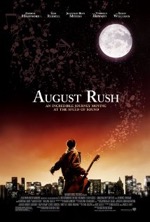
Starring: Freddie Highmore
November 2007
“Follow Your Heart…Follow the Music”
Ever seen a movie that had you convinced you were watching the greatest piece of cinema since Gone with the Wind until you left the theater and realized that your emotions had been manipulated by a mawkish screenplay and the cherubic face of an emerging acting prodigy? That’s the effect August Rush, director Kirsten Sheridan’s overly sentimental tear-jerker, had on me.
Evan (Freddie Highmore) was given up for adoption at birth. Now eleven, Evan runs away from an overbearing orphanage and embarks upon an incredible journey to find his parents. His parents—Lyla (Keri Russell), the cellist in a New York orchestra and Louis (Jonathan Rhys Meyers), the lead singer of a struggling rock band—met and conceived Evan on a one night stand…and then never saw each other again.
Evan possesses exceptional hearing abilities: he can pinpoint, filter, combine or adjust specific sounds to create musical compositions in his mind. He stands at a busy corner in NYC and, as if in a trance, conducts the cacophony of sounds that fill the air around him. Evan believes that following the music will one day lead him to his parents.
In Central Park, Evan encounters a talented young guitarist who takes him to a group of homeless musicians. In exchange for food and a place to sleep, the orphans pay tribute to the Wizard (Robin Williams), a surrogate father who exploits their talent for financial gain. It’s the Wizard who bestows the titular nickname upon the youth, but Evan is cautious of the capricious adult and soon breaks away from him and his musical misfits. Evan’s prodigious knowledge of music eventually leads him to The Julliard School of Music and ultimately back to his parents—ironically, Evan’s parents are drawn to his music, not the other way around. The movie climaxes with an emotional family reunion that, thankfully, doesn’t overstay its welcome.
A modern retelling of Oliver Twist, August Rush also borrows from many other “orphan seeks parents” films. However, the movie’s performances bail out the oft-sappy story: Russell, Rhys Meyers and Highmore are all superb, and Williams’ Fagin archetype is wonderfully nuanced and worthy of Oscar consideration.
Even though much of the movie seems far-fetched (an eleven-year-old at Julliard?) and oppressively heavy-handed, August Rush somehow manages to entertain and inspire. If the film’s ending feels a bit abrupt, know that it’s probably a blessing in disguise since a dénouement of any length would have tipped the scale from saccharine to maudlin. And no one would want to rush out and see that!
Rating: 3
Mr. Magorium’s Wonder Emporium (G)
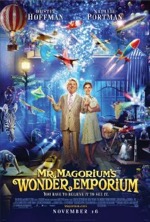
Starring: Dustin Hoffman
November 2007
“Forced Smiles with Foisted Fun for All”
Mr. Magorium’s Wonder Emporium, written and directed by Zach Helm, is the story of a magical toy store and its peculiar, titular owner. The store, squeezed between two tall buildings, looks exactly as it should—Elizabethan façade painted in gaudy colors on the outside, with a Wonka-esque toy store on the inside. The store houses a wide array of unique treasures, including: live fish mobiles, rollicking balsa wood T-Rex’ and bouncing balls that try to escape the store by jumping into customers’ shopping bags.
In preparation for retirement, Magorium (Dustin Hoffman) hires accountant Henry Weston (Jason Bateman) to set his affairs in order before handing over the store to his protégé, Molly (Natalie Portman). I always worry about revealing too much in a synopsis, but in this case, spilling the beans is unavoidable. I’ve already divulged the entire plot…sorry. With its paper-thin premise, saccharine sentimentality and an utter lack of conflict, the film offers very little else to discuss.
That’s not to say that Magorium doesn’t have its fair share of heart-warming moments. An adorable little boy named Eric (Zach Mills, who also serves as the movie’s narrator) brings whimsy and wide-eyed amazement to the film and is, sadly, and ironically in Magorium’s case, the only character to do so. There’s an amusing little scene where Eric tries making friends with Henry; Eric writes notes on a dry erase board and lifts it up to the window separating the two. “Want to play checkers when you stop working?” Henry replies with a handwritten message on a legal pad: “I never stop working.” Eric responds with a frowny-face. There’s also a cute little stuffed monkey that reaches out to hug Henry, but the harried accountant hurriedly and heedlessly walks by, producing an “aww” of sympathy from the audience. It’s a moment.
Hoffman’s performance falls woefully short of what it should have been, especially when considering the actor’s immeasurable range. Hoffman was brilliant as the bumbling Mumbles in Dick Tracy (1990), but here the veteran actor tries too hard to be likable and ends up making Magorium an eccentric busybody, complete with Lyle Lovett coiffure and a faux lisp so annoying it would make fingernails-on-a-chalkboard sound like the Hallelujah Chorus. Why would such a decorated actor select such a pedestrian role with such little charm and imagination? Portman tries her hardest to make Molly a complex character, but save for the subplot involving Molly’s ambivalence over wanting to be a concert pianist and feeling honor bound to take over the toy store, there’s very little for her to do…besides stew over Magorium’s departure or believe in a mystical block of wood that holds the secret to the store’s magic.
And speaking of magic; it’s one of the movie’s buzzwords. As such, it’s utterly ironic that a movie so preoccupied with magic should have so little movie magic. Any amazement the movie provides is foisted upon the spectator like a Jedi knight waving his hand and mentally suggesting, “You will gasp in astonishment at this scene. You will think this movie is magical.” It’s a shame that the creative minds behind the movie felt they had to assert the store’s magical qualities instead of simply showing them.
Mr. Magorium’s Wonder Emporium will surely captivate pre-teens with its semblance of magic, but anyone else, especially today’s savvy teens, will see right through the movie’s veneer of colorful sets and props and realize that more fun could be had at the local arcade than in Magorium’s gimmicky emporium. This Wonka wannabe might be full of wonder, but it certainly isn’t wonderful.
Rating: 2
Martian Child (PG)

Starring: John Cusack
November 2007
“Boys to Men…Martian Style”
Martian Child is the story of a troubled young boy, Dennis (Bobby Coleman), who believes he’s from another planet and the sci-fi novelist, David (John Cusack), who adopts him. Pale-skinned Dennis (who has an aversion to sunrays) is socially maladjusted, has bouts of kleptomania and only eats Lucky Charms. On balance, Dennis is exceptionally bright, has an insatiable curiosity about science and boasts extraordinary abilities—he claims that he can taste colors. Dennis’ mission, purportedly assigned by leaders on his home world, is to learn what it’s like to be part of a human family.
David doesn’t know the first thing about parenting and Dennis proves to be much more difficult to manage than the average 6-year-old kid. Their unusual, familial dynamic, which creates a variety of situations ranging from the comedic to the dramatic, forms the foundation of the story written by Seth Bass and Jonathan Tolins, based on the novel by Star Trek scribe, David Gerrold.
When Dennis says something bizarre—like when he calls the family dog a flomar, which means “warm, furry friend” in Martian—David exasperatedly replies, “I deserve you.” The beauty of the story is that David and Dennis both deserve, and need, each other. David is mourning the recent loss of his wife and Dennis is angry and confused about being abandoned by his parents at birth: both must learn to rely on the other in order to move forward in life.
Coleman is simply adorable in the film: the precocious actor imbues Dennis with the perfect blend of angst and child-like innocence. Cusack anchors the movie with his exceptional performance; he infuses David with the appropriate amount of humanity and vulnerability in a role that properly showcases his expansive range. In a serendipitous bit of casting, Cusack’s real life sister, Joan, plays his onscreen sister. Other key, supporting performances are turned in by Amanda Peet as David’s longtime friend, Oliver Platt as David’s off-kilter publicist, Anjelica Huston as a high-powered editor, Sophie Okonedo as an adoption agent and Richard Schiff as the child services watchdog.
If Martian Child feels familiar somehow, it’s because the movie shares story elements with such films as Powder (1995) and K-PAX (2001). However, despite its derivative storyline, Martian Child is a heart-warming exploration of the human condition as seen through the eyes of a misfit child. The film is also a clinical examination of our deep-seeded need for love, acceptance and security, and as Dennis establishes in the film, these are basic, human needs…even on Mars.
Rating: 2 1/2
Dan in Real Life (PG-13)
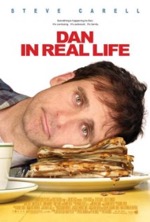
Starring: Steve Carell
October 2007
“Unexpectedly Poignant Dramedy from the King of Camp”
The family reunion movie has been done a thousand times before, but thankfully number one thousand and one saw the green light of day, because Dan in Real Life is a genuine gem filled with adult angst, familial strife and guffaws aplenty.
Dan Burns (Steve Carell), a well-known parenting expert who has his own radio program, whisks his three daughters off to his parent’s house in Rhode Island for a get-together. If Meet the Parents was set around a family reunion and only had a quarter of its clumsy mishaps, you’d have a pretty close approximation of Dan in Real Life. Whereas Ben Stiller’s Greg Focker was the very personification of Murphy’s Law, Dan merely has brushes with misfortune, like the occasional run-in with the same cop.
At the heart of the story is a painful-to-watch love triangle. Dan, who’s been a widower for four years, is just starting to work up enough courage to start dating again. Dan meets Marie (Juliette Binoche) in a bookstore and makes an instant connection with her. Hope is rekindled in his heart…a hope that’s quickly dashed when Dan learns that his new crush is actually his brother’s (Dane Cook) girlfriend. What a cruel world!
Dan spends the rest of the movie trying to stay out of Marie’s way while desperately trying to keep her out of his head; he manages to accomplish neither. Every time Dan sees Mitch and Marie’s public displays of affection, he mentally retches. Mitch and Marie are as mismatched as two people possibly can be; on the other hand, Dan and Marie are an eminently better suited couple…something everyone sees but no one voices. As Dan’s feelings for Marie intensify his behaviors become more extreme, and in the end Dan manages to alienate his family, loose the respect of his daughters and sabotage his best chance at rediscovering true love. Again, what a cruel world!
Despite instances of his patented, comedic shtick, this is Carell’s most serious role to date and he’s very effective at engendering sympathy from the audience as the black sheep of the family—Dan’s parents put him up in the laundry room and assign him to dish detail. Carell plays the pariah to the hilt; Dan is so hapless you just can’t help but feel sorry for him. Two must-see moments are the shower and burnt pancake scenes.
The movie’s synopsis is as basic as they come and its plot is unpretentious and uncomplicated, and yet the story contains some truly fine character studies and familial discoveries—the movie’s most effective attribute is its complexity amid streamlined simplicity. A family film that’s comical and inspirational, Dan in Real Life is one of the finest dramedies that’s come along in recent years. Highly recommended!
Rating: 3 1/2
Mr. Bean’s Holiday (PG)
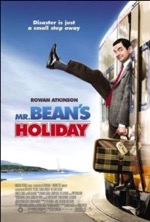
Starring: Rowan Atkinson
August 2007
“That’s One Big Step for Stupid-kind”
Like an ill wind, Bean is back! Rowan Atkinson’s quirky alter ego has returned to the big screen in Mr. Bean’s Holiday, director Steve Bendelack’s opus for the inane.
Winning a trip to France in a raffle, Bean is off on a journey of random events and slapstick silliness. Apart from the traditional points of interest in Paris, Bean’s main objective is to visit the world-famous beach at Cannes. As the plot unfolds, however, circumstances go from bad to worse, effectively maneuvering Bean farther and farther from his goal. Along the way, Bean looses all of his personal effects, save for his prized camcorder which contains a visual travelogue of his many misadventures—shot in a predictably haphazard style.
After nearly an hour of brain-shrinking idiocy, the movie stumbles into something that resembles a plot. Having been subjected to every one of Murphy’s Laws, Bean is forced to walk back to Paris on foot. Things heat up when Bean happens onto a movie set and ends up in the background as an extra. The Nazi-themed short is being helmed by Carson Clay (Willem Dafoe) an intense visionary who epitomizes art film directors; boundless energy and creativity with enough of a capricious streak to keep everyone on set on edge. After a long day of acting, Bean hitches a ride from an attractive young woman who is conveniently en route to Cannes; the film festival, not the beach, much to Bean’s disappointment. Bean’s luck finally takes an upswing when he preempts Carson’s self-aggrandizing indie film with his camcorder video and unwittingly becomes the highlight of the festival. But the overwhelming praise for his work, which has inspired a new movement in film, is lost upon a man who simply wants to get to the beach.
The movie is essentially a series of sight gags with some physical comedy sprinkled in, all of it done in Atkinson’s patented style which was made famous in his BBC TV show, Mr. Bean. This is the second Bean film released in the US, and although it’s charming, the tenuous screenplay relegates the film to a level of mediocrity that would leave the typically speechless Bean cursing a blue string.
Mr. Bean’s Holiday is about as silly as they come, but it accomplishes its purpose and showcases some truly breathtaking snapshots of the French countryside. This isn’t cinematic high art…it’s a popcorn flick, and as such, is a great way to escape into a mind-numbing delirium for two hours. There are worse ways to waste time. Whether or not this movie warrants another installment in the slapstick series, one thing’s for sure…Bean is a dip!
Rating: 2
The Bourne Ultimatum ( PG-13)
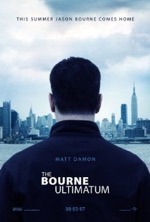
Starring: Matt Damon
August 2007
“Ultimatum is the Ultimate Bourne Adventure”
Bourne is back…with a vengeance! The Bourne Ultimatum, the third movie based on the thrill-packed trilogy by the late Robert Ludlum, brings the story full circle—back to NYC where it all started for Jason Bourne (Matt Damon), the fugitive of a top-secret governmental agency who trained him to be a no-nonsense, no compunctions assassin. The movie also brings back the fun and excitement of the first film, which was throttled back a bit in the middle chapter.
Globetrotting like Sydney Bristow in Alias, Bourne travels to several countries as he attempts to unravel the secrets of his past, which haunt his dreams but evade his conscious awareness. The taut actioner features Bourne surviving a shootout at London’s Waterloo Station, a high-speed motorcycle pursuit in Morocco, a pulse-pounding rooftop chase which culminates in a kick butt hand-to-hand melee and a car chase in NYC that climaxes with the most jarringly realistic crash ever committed to film. But all of these scenes pale in comparison to the jaw-dropping revelation at movie’s end when Bourne learns who he really is and how he became a cold-blooded killing machine.
The screenplay, by Tony Gilroy, Scott Z. Burns and George Nolfi, is a thoroughly enthralling yarn that boasts one of the most inventive, non-linear plot lines to come along in quite some time. Though the film is unabashedly action-packed from start to finish, director Paul Greengrass skillfully safeguards the movie’s refreshingly rich character development from being overshadowed by frenetic fistfights and explosions, a key to the film’s delicate balance between action and drama.
Though Ultimatum is the most emotionally and physically demanding Bourne outing yet, Damon handles the part with practiced ease, proving beyond any doubt that he belongs in the upper tier of action stars. Damon anchors the film, but the fine supporting players lend the film added depth. Joan Allen and Julia Stiles reprise their roles as FBI agents and are joined by movie legends Scott Glenn, David Strathairn and Albert Finney, each of whom turn in powerhouse performances in key roles.
“This is where it started for me,” Bourne states near the climax, “this is where it ends.” So, is this the end of the series or will Damon become Bourne again? The Bourne Legacy and The Bourne Betrayal (further Bourne adventures written by Eric Van Lustbader), could certainly provide fodder for future films, so time will tell. As things stand, the Bourne movies comprise one of the most exhilarating, and most exhausting, action trilogies in modern cinema.
Rating: 3 1/2
No Reservations (PG)

Starring: Catherine Zeta-Jones
July 2007
“Bittersweet Treat with a Dash of Romantic Tension”
I once knew a guy who possessed an almost unnatural insight into cooking: as if reciting an Emeril show, he instructed me on what steps and which ingredients needed to go when and where to produce a savory meal…which he had just conjured up in his head and instinctually created right before my very eyes. A similar, if more professional, display of culinary genius is showcased in No Reservations, a dramedy centered on a 5-star eating establishment in NYC.
Catherine Zeta-Jones plays Kate, a workaholic chef whose ineptitude at raising children is magnified to frightening new levels when her niece, Zoe (Abigail Breslin), comes to live with her. Kate, who knows nothing about making meals for kids, serves Zoe duck for lunch and a fish (with head and tail still attached) for dinner.
Kate’s rival at work is insouciant sous chef, Nick (Aaron Eckhart). Nick’s unpredictability and fun-loving manner comes off as irreverence to Kate, especially when Nick shows up to work in his pajamas and conducts an opera with soup ladles. Kate’s problems surmount when Zoe takes a shinning to Nick and her intensifying feelings for Nick boil over, setting up some amusing interplay between the principle characters.
There’s nothing flashy about No Reservations, and that’s probably what makes it charming rather than cloyingly sentimental. The performances are sincere and bring balance to a story that easily could have digressed into a mawkish tear-fest were it not for sure-handed direction by Scott Hicks and a solid screenplay by writers Carol Fuchs and Sandra Nettelbeck. Zeta-Jones plays high-strung and lovelorn Kate to perfection and Eckhart imbues Nick with the perfect blend of boyish charm and rugged refinement. Breslin (Little Miss Sunshine) shows her serious side in her portrayal of a grieving pre-teen trying to accept the death of a loved one while adjusting to new house rules.
Though the film is a tad heavy-handed in the “tug-on-your-heartstrings” department, it’s a feel-good love story that’s sure to be a crowd-pleaser. Effectively balancing light-hearted moments with mature themes, No Reservations has all the right ingredients. As such, I have no reservations about recommending the film. Soup’s on!
Rating: 3
Hairspray (PG)

Starring: John Travolta
July 2007
“A Musical Comedy That Really Takes Hold”
Based on the earlier film (1988) and Tony Award-winning Broadway musical (2002) of the same name, Hairspray’s filmic second coming is a delightful, toe-tapping romp. Boasting a luminous cast, including: John Travolta, Michelle Pfeiffer, Christopher Walken, James Marsden, Amanda Bynes, Brittany Snow, Zac Efron, Allison Janney and Queen Latifah, the film also introduces exuberant newcomer, Nikki Blonsky, who plays “pleasantly plump” Tracy Turnblad…the big girl with big dreams of being a dance star.
Tracy faces stiff competition (from significantly slimmer women) when auditioning for the American Bandstand clone, the Corny Collins show—the highest rated program in its time slot on the local access channel in Baltimore, MD, circa 1962. Tracy’s father Wilbur (Walken), a struggling novelty store owner, is supportive of Tracy’s dream, whereas her mother, Edna (Travolta in drag), a stay-at-home laundress, attempts to quash Tracy’s dreams to protect her daughter from the pain of rejection.
Why Hairspray’s brain trust saw fit to cast Travolta as Tracy’s mom is anyone’s guess, but the Grease vet is surprisingly convincing in the role and shines in the “Timeless to Me” number; Walken, drawing upon his musical theater background, is also delightful in the scene. Pfeiffer, another Grease alumna, is delicious as the arrogant TV producer, and Marsden, as the cheesy dance show host, has never looked or sounded better onscreen—maybe he should quit his day job. As for Blonsky, she was working at Cold Stone Creamery in her hometown of Great Neck, New York when she was selected to play the ebullient youth. Blonsky was the natural choice to play persecuted Tracy; while growing up, the actress had endured similar teasing from her perfectly proportioned classmates. It’s nice to see a good girl finish first, especially one with genuine talent.
The movie’s musical numbers are first-rate, especially the dance floor jigs for the Corny Collins Show and the Hairspray Pageant. Serving as commas to the brilliantly choreographed dance songs are some surprisingly meaningful character moments and poignant social issues, such as: marital fidelity, interracial relationships, prejudice over race or weight and the battle for social progress. Amazingly, the story is just as relevant today as it was in ’88 when John Waters penned the original script; proof positive that the more things change, the more they stay the same.
They say hairspray is bad for the environment, but this Hairspray is a can of good, clean fun. While many will find the film entertaining, if even a few come away with a better understanding of the dangers of marginalization, so much the better. Spray away!
Rating: 2 1/2
Harry Potter and the Order of the Phoenix (PG-13)
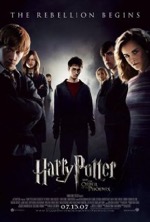
Starring: Daniel Radcliffe
July 2007
“Dark and Dreary is the Order of the Day”
The last Harry Potter movie, The Goblet of Fire, was darker than the opening trilogy but retained much of the whimsy and magical energy that permeated the earlier movies, based upon J.K. Rowling’s mega-blockbuster fantasy series. The fifth Potter film, The Order of the Phoenix, is even darker than the previous entry. But is it too dark?
Some would argue that this is the most character-driven film in the series—brimming with revelatory moments of shadowy pasts and meaningful vignettes where honesty and vulnerability bubble to the surface in the seething cauldron of false accusations, social stigma and detrimental denial—and they would probably be right. But what the movie gains in dramatic capital it looses in slow pacing, drab sets, standard special effects, low creativity and, when compared to the other films, a veritable absence of action scenes. Since characters are crucial to the plot, it’s wholly appropriate to present a brief character study of the main players and the new challenges they face.
Harry (Daniel Radcliffe) is a pariah in the film; despised and distrusted by adults and contemporaries alike, he’s seen as a kind of Chicken Little where the imminent return of the evil lord Voldemort (Ralph Fiennes) is concerned. As the film progresses Harry becomes increasingly angry, a la Anakin Skywalker, and distances himself from his diminishing circle of friends which are little more than glorified extras here, especially Hermione (Emma Watson). To make matters worse, Voldemort makes repeated attempts at getting inside Harry’s head and the lad seems to be on trial for one Hogwarts violation or another for at least half the film. Oh, and Harry’s most ardent defender, wizard Dumbledore (Michael Gambon), all but ignores Harry in the film. Even though a plausible explanation is given for his odd behavior, the sullen headmaster seems out of sorts and out of character for most of the movie…a little disappointing.
Harry’s godfather, Sirius (Gary Oldman), fittingly, has risen up from the embers to join the Order of the Phoenix—Sirius holds out hope to the movie’s oppressive darkness. Unfortunately, the movie doesn’t return the favor. Furry fan-favorite, Hagrid (Robbie Coltrane), appears in the film for about ten minutes, delivers about as many lines and then exits stage right. This is unacceptable treatment for such a beloved character. Adding insult to injury is the subplot with Hagrid’s giant half-brother; the silly and superfluous scenes could have been cut from the movie with little consequence.
Token scenes are doled out to the majority of peripheral characters, like Alan Rickman’s ever-dour Professor Snape. Though Rickman’s scenes are inexcusably few, his character is party to some of the meatiest moments in the movie; like when Snape forces his way into Harry’s mind to help the lad build up defenses against Voldemort’s mental assaults…and when Harry, in the process of shoving back, learns a shocking and ironic fact from the brooding teacher’s past.
If there’s one area of the movie that works like magic, it’s new headmaster, Miss Umbridge (Imelda Staunton), a condescending snoot who’s actually a more effective antagonist than Voldemort. A good villain makes you want to take off your shoe and chuck it at the screen; Umbridge comes close to evoking that kind of unbridled hostility in spectators with her simpering smile and prim and proper schoolmarm rigidity. Hogwarts experiences its darkest days under Miss Umbridge’s tyrannical rule: again, is there a hint of felicity or optimism anywhere in the movie? Not to this muggle’s eye.
As with the other Potter films, the technical and artistic elements in Order are impervious to criticism, but no amount of special effects or artistic embellishments can rectify a dismal screenplay. The word from avid Rowling’s readers and Hollywood insiders is that the next book, The Half-Blood Prince, is even darker than Order. That doesn’t bode well as this installment was already too dark for my liking. What happened to the levity? What happened to the innocence and excitement at discovering new worlds, peoples, creatures and cultures? What happened to walking out of a Potter movie feeling exhilarated instead of feeling like you just left a wake? Hopefully number six will shed some light on these questions. Expecto patronum!
Rating: 3
Transformers (PG-13)
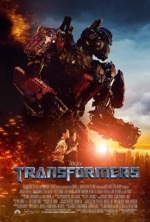
Starring: Shia LaBeouf
July 2007
“Shia Steals the Show from Shape-shifting, Sentient Machines”
Director Michael Bay’s latest big screen extravaganza, Transformers, is based on the 80’s cartoon series and comic book of the same name. Having never seen the cartoon (despite being a child of the 80’s), I really didn’t know what to expect, but was dubious about the film’s potential because of its pedestrian roots. However, Transformers far surpassed my expectations; not only was I blown away by the movie’s dazzling FX, I also was captivated by the gripping human drama which somehow manages to hold its own against the overwhelming onslaught of morphing machines.
Sam (Shia LaBeouf), the resident history nerd at his high school, is undersized for his age, stumbles over his words and couldn’t buy a date with all the gold in Ft. Knox. But Sam’s fortunes change when his dad takes him to a used car lot and a yellow Camaro selects him just like Herbie The Love Bug (1968) selected Dean Jones in Disney’s campy classic. While out for a spin in his new car, Sam spots the hottest girl from his school walking alongside the road; the Camaro takes control of the steering wheel, opens its passenger door and presents Sam with the opportunity of a lifetime. But, as Sam soon learns, his eccentric car is more than meets the eye.
The movie’s geek quotient is pretty high, especially since it borrows heavily from the cartoon’s glossary. If you pinch your nose, you might be able to swallow names like Megatron and Optimus Prime (although Sam’s car, Bumblebee, might be pushing it), but don’t be surprised if some acid reflux works its way up into your throat when you hear nomenclature such as Autobots, Decepticons or the groan-inducing All Spark. If you can get past these elements while suspending your disbelief at least as high as you did for Independence Day (Bay’s other alien invasion flick), you’ll probably thoroughly enjoy Transformers.
I mention Independence Day because Transformers sets up in a similar fashion, gradually unraveling the extraterrestrial threat before blowing the roof off the theater with a pulse-pounding, earth-shattering finale. Another common factor between Bay’s films is the manner in which the different sets of characters are introduced—the everyday folk, governmental officials and members of the military—and how the story bounces back and forth between the groups until they finally intersect during the cataclysmic climax.
LaBeouf’s (Holes) contribution to the movie’s success cannot be understated—he simply steals the show with his nervous bumbling and Average Joe charm. Other members of the eclectic ensemble are: Mikaela (Megan Fox) as Sam’s crush, Josh Duhamel (Las Vegas) as a special ops soldier, Jon Voight as the secretary of defense and John Turturro as a member of an oversight-created rogue agency called Sector 7 (i.e., throwaway subplot).
Boasting groundbreaking CGI, Transformers will undoubtedly run away with the Best Visual Effects Oscar, even amid stiff competition from other big budget sequels like Spider-Man 3, Pirates 3 and Fantastic Four 2. Some FX highlights: scorpion-like transformers burrow under the desert sand and ambush a special ops team, and Autobots and Decepticons engage in a high-speed chase which essentially transforms the freeway into a roller derby. Also, the final confrontation between Optimus Prime and Megatron, where Sam desperately tries to evade the wrestling leviathans, is a mind-blowing scene that, like the climax of the first Matrix movie, has elevated the standard for big screen action sequences and set the bar that much higher for future filmmakers.
Transformers is the must-see movie this summer; not only because it’s wildly entertaining, but mostly because it’s something new. It’s also the finest teen angst story to come along in quite some time and should attract legions of pimple-faced patrons as well as thirty-something former fan boys seeking an exhilarating stroll down memory lane. Even though a sequel is all but assured, Bay and Co. would do well to proceed with number two only after a quality script is in place so as to avoid the ignominious fate of other big budget sequels released in recent years. After all, this first Transformers film will be a tough act to follow.
Rating: 3
License to Wed (PG-13)
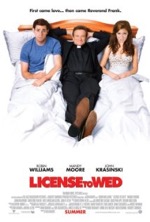
Starring: Robin Williams
July 2007
“License and Rolaids Please”
Premise:
To prove their compatibility as marriage partners, a young couple must endure the intensive, invasive and unorthodox marriage counseling methods of a radical minister.
Synopsis:
Sadie (Mandy Moore) insists on being married in the church her grandfather built, much to her fiancé, Ben’s (John Krasinski), persistent protestations. However, Reverend Frank’s (Robin Williams) calendar is so packed that he can only marry Sadie and Ben in three weeks…or sometime next year. Opting for the quicker course, Sadie and Ben are subjected to Rev. Frank’s extreme marriage prerequisite course which includes a variety of bizarre exercises. Rev. Frank’s lesson in communication sees Sadie driving blindfolded while Ben gives directions from the back seat. Rev. Frank bugs Sadie and Ben’s apartments to safeguard the couple against consummating their relationship before the honeymoon. Ben must contend with creepy robot baby twins which secrete all manner of fluids at random times in order to prepare him for fatherhood. These challenges drive Sadie and Ben further apart, which is, of course, all part of Rev. Frank’s plan. The couple breaks up, but will true love bring them back together in time to take the final exam?
Creative Contributions:
The film’s most obvious deficit is the anemic script. The premise is flimsy and the story isn’t substantial enough to hold up under its own preposterous notions. Ken Kwapis’ TV sitcom sensibilities shackle the story and William’s stale shtick kills any chance the movie has of being a charming, lighthearted look at prenuptial stress and strife. The Seed of Chucky demon-babies are downright disturbing as is Frank’s consistently deplorable behavior (just how many of Williams’ recent performances have involved eavesdropping, spying, voyeurism, etc.?)
Evaluation:
With unmistakable shades of Meet the Parents, License to Wed is a mindless rom-com that had the opportunity to explore the complexity of relationships in a mature and respectable manner, but settled for the cheap laugh instead. The formidable line-up of stars, along with solid assists from veterans like Peter Strauss and Wanda Sykes still couldn’t right the severely listing ship. Williams is regrettably hackneyed and is becoming more irrelevant with each successive role. Mandy Moore, bless her heart, has had terrible luck with her comedies at the box office this year. Better luck next year!
Rating: 1 1/2
Ratatouille (G)

Starring: Patton Oswalt
June 2007
“Anyone Can Cook…An Average Meal”
I’m a hypocrite! That’s the only possible explanation for my tepid reaction to Disney/Pixar’s new animated repast, Ratatouille. Even with rats overrunning the kitchen, the feast served up by director Brad Bird and his team of digital sorcerers has all the right ingredients, and yet, there’s one fundamental story element that stands out like a fly doing the backstroke in a bowl of soup.
The previous Pixar film, Cars, anthropomorphized automobiles in a way that was charming and disarming, even for someone like me—a guy so ignorant about cars I once paid a mechanic to change my air filter. How talking autos became so popular and endearing is anyone’s guess, but no one can deny that Cars has memorable characters, hysterical and heartwarming scenes and what every feature hopes to capture like lightning in a bottle…movie magic.
So why am I a hypocrite? I can suspend my disbelief for conversing cars, but I just can’t bring myself to believe in a gifted rat who teaches a numbskull human how to create gourmet meals that can make even the most jaded food critic gush forth praises like a Parisian fountain. If this were merely a throwaway subplot, I could have abided the preposterous story element for the sake of an otherwise delightful tale of friendship, teamwork and dogged persistence in pursuing a dream. Unfortunately, the relationship between rodent Remy (Patton Oswalt) and clumsy trash boy turned overnight cooking sensation, Linguini (Lou Romano), is the cornerstone of the movie. If, like me, you just can’t buy into the trans-species partnership, it won’t take long for you to detect this tenuous plot device, which continues crumbling throughout the movie like bleu cheese over a tossed salad.
However, there are some great sequences in the movie, such as; rifle-packing granny making Swiss cheese out of her house while trying to blast the vermin in her attic, the montage of shots that show Remy teaching Linguini how to cook by tugging on tufts of the boy’s red hair and the climactic scene when Remy enlists a legion of his friends to help save the day…and Linguini’s reputation. What’s refreshing here is that just beneath all the frenetic fun and frivolity, discerning viewers will find additional layers of meaning and salience. Themes such as confronting fear, leaving home, falling in love, overcoming prejudice and forging an unlikely friendship all find poignant expression in the film and are handled with the skill and artistry of a world-renowned chef.
It almost goes without saying that the film’s CG animation is amazing—each new Pixar film raises the standard for the rest of the animation industry. The first Pixar film to feature mice and men, Ratatouille has a unique palette which perfectly captures the mood and styles of Paris—the night skyline, complete with the majestic Eiffel Tower, is so sweeping and breathtaking it makes you want to rush right out and book a flight to France.
The animation is undeniably the movie’s piece de résistance, but the stellar vocal talents serve as the perfect garnish to this savory dish. Oswalt endues Remy with just the right mixture of wit, angst and pluck. Romano deftly performs hapless, clueless Linguini, but it’s Peter O’Toole, as cantankerous food critic Anton Ego, who steals the show with his rich, refined and resonant baritone. Other voices are provided by Brian Dennehey as Remy’s father, Janeane Garofalo as Linguini’s crush, Collette, Ian Holm as Skinner and Brad Garrett as Remy’s idol and mentor, Gusteau.
The more I reflect upon Ratatouille, the more I realize my judgments will seem too harsh, but, for the reasons stated above, I can’t give the movie the glowing recommendation it clearly deserves. Ratatouille has the same heart as the other Pixar animated releases, but doesn’t have the same magic. However, the movie still exemplifies quality, family entertainment and, undoubtedly, will find universal appeal and acceptance from critics and audiences alike. This is the first Pixar movie that failed to meet my expectations…but at the end of the day, an average movie from Pixar is still better than the finest work from any other animation studio. I’d gladly pass up their filet mignon for a bowl of Pixar’s peasant soup any day!
Rating: 2 1/2
Live Free or Die Hard (PG-13)
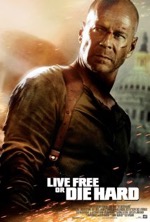
Starring: Bruce Willis
June 2007
“Old Action Stars Never Die…They Just Do Mediocre Sequels”
Life imitating art, and vice versa, has fueled many debates on ethical standards over the years, especially since societal ills are often blamed on one or the other. Executive Decision (1996), which starred Kurt Russell and Steven Seagal, focused on terrorists who hijack a jet and threaten to release a poisonous gas over Washington D.C. if their rebel leader wasn’t immediately released. Five years later our nation watched in disbelief as two commandeered jets crashed into the World Trade Center buildings, another grazed the Pentagon and yet another, United 93, crash landed in a Pennsylvanian field after its brave passengers prevented the plane from reaching its destination…the White House. Did Al-Qaeda come up with the idea of using jets as weapons all by themselves, or were they inspired—if only in small part—by the fertile minds in Hollywood?
In Bruce Willis’ new John McClane movie, Live Free or Die Hard, writers Mark Bomback and David Marconi set up a scenario where domestic terrorists (to keep things P.C.) hack into our government’s mainframe and create a “fire sale”—the crippling of our traffic control, financial and utility systems. As I was introduced to this new, potential threat to our country, the question that immediately popped into my head was, “Do we really need to give them any more ideas?”
In the film’s defense, the Die Hard series, since its pulse-pounding inception in 1988, has consistently featured nefarious types (generally from overseas) and their fanatical plans to commit acts of terror on our soil. However, the earlier trilogy was released before 9-11, and it goes without saying that the rules of the game have changed since then; leaving Live Free or Die Hard with no leg to stand on should an actual fire sale ravage our nation in the near future. There’s an old saying that goes, “Fool me once shame on you, fool me twice shame on me.” If an attack of this magnitude were carried out in our country, we would indeed be fools for having allowed our security to be threatened by an insidious plot packaged as entertainment and disseminated, en masse, at the Cineplex.
It’s a profound irony that the movie’s strongest element is the terrorist plot; on the flip side, the biggest contributors to the movie’s fits of incompetence are the flawed screenplay and static acting. Willis’ performance is exceedingly and disappointingly wooden; he delivers his lines with a swaggering overconfidence (the unfortunate side effect of being too comfortable with the role), which devolves McClane from character to caricature. The movie’s dialogue is as expressive and variegated as a telegram, and you just had to know that “Yippee ki yay” would be uttered somewhere in the film. Willis’ onscreen sidekick, Matthew Farrell (Justin Long), is just as off-putting as Mos Def’s nasally nitwit in Willis’ 16 Blocks, and the rest of the cast is largely forgettable.
The movie’s action sequences, though dynamic and frenetic, are so far-fetched they’ve actually redefined the word absurd. Semi vs. F-35 jet…need I say more? Actually, I think I will. I know the words Die Hard appear in the title, but just how difficult is it to kill John McClane, or wound or even bruise him? Like the old Timex slogan, McClane “takes a lickin’ and keeps on tickin’,” but credibility is shot to blazes when McClane takes a beating and then immediately gets up—without a scratch, mind you—and rushes headlong into the next action sequence. Most action movies push the limits of believability in this area, but Live Free or Die Hard conveniently tosses physical limitations and human attrition out the window. Maybe Willis is unbreakable?
Director Len Wiseman’s (Underworld) extensive background in various behind-the-scenes capacities clearly paid dividends in the movie’s top-notch production values, but he wasn’t nearly as effective at evincing convincing performances from the cast. As they say, you can’t squeeze blood from a turnip…you can’t produce Oscar-caliber performances from cardboard characters either. You’d have thought that after a twelve year sabbatical the fourth Die Hard film would have given us more to talk about than Bruce Willis’ bald head. So much for, “Good things come to those who wait.”
So, will John McClane return to save the world once again or will the series languish another decade and die? Hard to tell, but Stallone recently resurrected Rocky, so you never know. Where there’s a Willis there’s a way.
Rating: 3
Evan Almighty (PG)
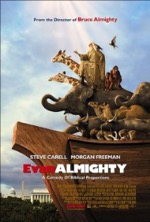
Starring: Steve Carell
June 2007
“A Flood of Levity with a Sprinkle of Morality”
The follow-up to the divine comedy Bruce Almighty (2003), which starred Jim Carrey and Morgan Freeman, Evan Almighty features Steve Carrell as a modern-day Noah who’s been instructed to build an ark by God—once again personified by Freeman.
Evan Baxter (Carrell) was a curious choice for lead character since he was Bruce’s rival in the earlier film. The transition from antagonist to protagonist (and anchorman to congressman) might be too much of a stretch for some viewers; such an obvious contrivance challenges the movie’s credibility right out of the gate. Carrell’s usual antics are toned down here a bit, but the role consistently defaults to the comedic rather than the dramatic and crosses the border of silliness on a fairly regular basis; like when Evan tries to keep up with his rapidly growing beard or when a veritable zoo follows him around town and even accompanies him to congressional meetings.
Among the notable cast members are: John Goodman as a shady politician, Lauren Graham as Evan’s exasperated wife and Wanda Sykes as Evan’s quick-witted secretary. Save for Carrell and Freeman, the movie’s performances are as wooden as the ark but this is mindless comedy, not Shakespeare (thank goodness; Carrell is a far cry from Olivier).
Joel Cohen’s script is considerably tamer than the brazenly irreverent Bruce Almighty and, for better or worse, the movie will be classified as a family film. From a moral or religious standpoint, there’s absolutely nothing objectionable in the film and some of the inside gags—Evan’s alarm clock rouses him at exactly 6:14 and his new license plates read GEN 6:14, the Bible verse that commanded Noah to “Make thee an ark of gopher wood”—are quite amusing. Even though the plot is flaccid in spots, credit Cohen for taking the movie in a different, if less interesting, direction than the first film.
Evan Almighty is good, clean fun that features a diverting premise and a positive moral: you can change the world “one act of random kindness at a time.” It’s an oversimplified maxim that’s made palatable only because Freeman delivers it—after all, he, not Bruce or Evan, is the Almighty.
Rating: 2 1/2
Fantastic Four: Rise of the Silver Surfer (PG)
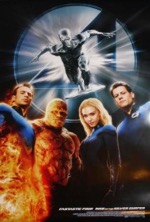
Starring: Ioan Gruffudd
June 2007
“The Surfer Brings Home the Silver Medal”
What if a malevolent entity, born in the womb of deep space, roamed among the stars and instigated intergalactic upheaval by eating planets for breakfast? What if a humanoid on a threatened world made a deal with the cosmic devil to spare his planet in exchange for his eternal servitude to the sinister overlord? And what if that harbinger of destruction showed up on earth?
That, in a nutshell, is the tragic dynamic of Galactus and his henchman, the Silver Surfer. It’s also the premise of the second Fantastic Four movie, subtitled, Rise of the Silver Surfer.
The movie opens with the media frenzy surrounding Reed Richards’, a.k.a. Mr. Fantastic (Ioan Gruffudd) and Sue Storm’s, a.k.a. the Invisible Woman (Jessica Alba), high profile wedding. Sue is beyond frustration with Reed, whose obsession with his work relegates her to making all of the wedding plans. The afternoon of the wedding finds Reed up to his elastic elbows in work as he frantically labors to bring an advanced satellite (an early detection system for rogue spatial anomalies) online. As the story would require, just such an anomaly rapidly approaches earth and trips Reed’s alarm before he can say “I do.” Riding a cosmic wave at near-light speed, the Surfer arrives at earth and crashes Reed’s wedding…of all the events taking place on the planet. Many melees erupt throughout the movie giving rise to the question, “Will the combined strength of the Fantastic Four be enough to defeat the Surfer?”
Though the sequel is darker and less frivolous than the original, both movies are equally good; though neither one is great. What works particularly well in the movie is the inherent sense of dread that surrounds the mysterious Surfer and the imposed deadline that comes with his arrival. “Wherever the Surfer goes, eight days later and the planet dies,” Reed gravely informs his team. However, since the movie chronicles our planet’s first encounter with the shinny guy, how could Reed possibly know such information…intergalactic talk radio?
Earth’s impending demise becomes a dreadful reality when the Surfer burrows massive holes deep into the earth’s mantle at various points around the globe—the tableau of one such hole inside the dried out Thames is a striking visual. The purpose of the holes is revealed when Galactus arrives at earth during the movie’s harrowing climax; the cloud-like creature’s attack on earth is yet another breathtaking sequence.
The Surfer, himself, is perhaps the movie’s finest visual effect. The scenes of the Surfer passing through buildings, flying upside down through traffic, etc., are too numerous to mention here, but the look and mystique of the liquid-chrome humanoid—further enhanced by Laurence Fishburne’s authoritative baritone—simultaneously strikes fear into our hearts and fosters respect for one of the baddest-looking villains to have come along in recent years. It’s just too bad the writers didn’t spend as much time on his character development as the FX team did on his CG rendering.
In keeping with the number of the titular team, the movie’s top four drawbacks are: 1. it’s too slow out of the starting blocks, 2. Johnny Storm/the Human Torch (Chris Evans) is so obnoxious I actually hoped the Surfer would squeeze his neck until his big, flaming head popped off, 3. Ben Grimm/The Thing (Michael Chiklis) could hold a pose in front of a brick wall and stand out more than he does in the film, and 4. Sue’s distracting, blue-ringed contacts are the only memorable element of Alba’s performance. Despite leaden acting, especially by Julian McMahon as the resurrected Dr. Doom, and the remedial dialogue that sounds as if it were lifted right out of the comic book, the movie is a fun popcorn flick that’s no better, yet no worse than the first Fantastic film.
Some suggestions for the third installment: bring back the humor from the first film; give each of the four characters something to do along with a new, personal challenge and present the movie as a thought-provoking, issues-driven action film (using the X-Men trilogy as a template) rather than a glorified comic book. That would be fantast… Uh, fabulous!
Rating: 2 1/2
Ocean’s Thirteen (PG-13)
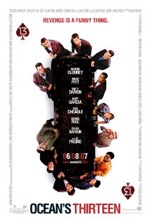
Starring: George Clooney
June 2007
“Clooney and Co. + Pacino = Lucky 13”
Steven Soderbergh’s Ocean’s Eleven was a rollicking riot of a good time, but the follow-up, Ocean’s Twelve, failed miserably because it tried to be too slick for its own good. Ocean’s Thirteen finds Danny Ocean (George Clooney) and his criminal cronies returning to Sin City, and fortunately for us, the fun has returned as well.
When casino tycoon, Willie Bank (Al Pacino) double-crosses Reuben (Elliott Gould), Danny hatches a plan that will repay Bank with interest for his ill-conceived ill turn: 1. sabotage the opening of Bank’s new casino so that it fails to receive a 5-star rating and, 2. swipe Bank’s cache of priceless diamonds before he knows he’s been hit.
All of the regulars are back, sans the women (Julia Roberts and Catherine Zeta-Jones); but even without the female headliners it still must have been a Herculean task to synchronize the schedules of so many A-list actors. Though this is primarily George, Brad and Matt’s movie, everyone is given generous screen time here…unlike the second film, which relegated secondary characters to marking time in jail until they could make a significant contribution to the story. Some of Ocean’s cohorts, like Virgil (Casey Affleck) and Turk (Scott Caan), have considerably more involvement here than in the earlier films; their side story in Mexico is uproariously funny.
Al Pacino was the perfect choice for billionaire Bank. Besides perfectly inhabiting his character and seamlessly blending in with the rest of the high-powered cast, Pacino brings legendary gravitas to the part of the nefarious antagonist. Andy Garcia played an adequate heavy in the first film, but the villain in the second movie was instantly forgettable. Pacino’s Bank is the best Ocean’s villain to date because he strikes the perfect balance of loathing and respect in the spectator; an effective combination.
The previous Ocean’s films utilized narrative sleight-of-hand and flashback sequences to reveal the intricacies of the heist, but this film doesn’t have any tricks up its sleeve. The straightforward storyline lulls the audience into thinking they have it all figured out, and then broadsides them with one mind-blowing twist after the next. You’d think—from a creative standpoint—that this type of plot structure would be less imaginative and more constrictive, but when random deviations start to derail Ocean’s painstakingly calculated plan, the movie actually becomes more enjoyable than if writers Brian Koppelman and David Levien had regurgitated the same well-worn storytelling device employed in the earlier films.
Ocean’s Thirteen has restored the series to its former, fun-loving form. Now the question is: Will there be an Ocean’s Fourteen? Like most Hollywood films, especially sequels, it’ll be a crapshoot.
Rating: 3
Pirates of the Caribbean: At World’s End (PG-13)

Starring: Johnny Depp
May 2007
“Scatterbrained Sequel Makes Us Grateful for ‘The End’”
In preparation for this review, I was half tempted to write, “Please refer to my review for Pirates 2.” After all, both movies were filmed at the same time and both suffer from writhing, meandering story lines packed to the gunnels with bizarre characters, insipid love triangles and as much obtuse silliness as Johnny Depp can cram into each millisecond of his onscreen time. With their numerous inherent similarities and identical ratings, it’s hard not to point this review to my earlier one, so if you’re so inclined…
Before Depp and crew sailed into our collective consciousness, pirate-themed movies had never been very successful at the box-office. In fact, the finest example the genre had produced in recent years was the debacle known at Cutthroat Island (1995), which starred Geena Davis as a swashbuckling heroine and Matthew Modine as her quick-witted sidekick. With very few exceptions, pirate movies have fallen short of anything remotely resembling high art and have been widely rejected by audiences and critics alike. But that knowledge didn’t stop Disney from rolling the dice on a movie, now trilogy, based on one of its theme park rides…which would seem to be double jeopardy since the other films based on Disney rides, Country Bears and The Haunted Mansion, were undisputed flops. The first Pirates movie was slightly above average, but each sequel has failed to live up to its predecessor (further substantiating the cloning principle of replicative fading) by moving farther away from the comical and whimsical joyride that was the original.
In some ways, I enjoyed this new Pirates film, subtitled At World’s End, a swabbie’s chin whisker more than the middle movie—it has a stronger opening act, is darker and moodier, isn’t quite as pedestrian in the script department and features action sequences that your brain can almost keep up with…almost. Although the overarching plot and purpose is a bit nebulous, some of the movie’s subplots actually make sense this time; like Capt. Jack Sparrow’s (Depp) rescue and the Council of the Nine Pirate Lords.
Unfortunately, this movie has succumbed to the same kind of free-wheeling buffoonery that plagued Pirates 2; for supporting evidence, look no further than the inane scenes where Sparrow carries on conversations with his cadre of imaginary alter egos. What’s more, Jack and Will are still at odds with each other and allegiances continue shifting like the wind: the parlay scene on the island spit, where Barbossa (Geoffrey Rush) and Will (Orlando Bloom) switch sides, reminds me of picking teams at recess. Boy, have these movies regressed. Thankfully, the story’s anemic ménage trios is finally resolved, but Barbossa’s mysterious return from the dead at the end of Pirates 2 is given the barest of explanations here, but hey, this is just escapist fare so who cares. Right?
In 2006, Pirates 2 won the Oscar for Best Achievement in Visual Effects, and Pirates 3 seems poised to nab the statuette for the second year in a row. In addition to spirited ship battles (like the show-stopping shot of the Endeavor exploding into smoldering splinters), the CGI on Bootstrap Bill is amazing, especially when the barnacle-encrusted prisoner becomes one with the wall of coral in his cell. The movie’s cinematography is also superb, particularly in such tableaus as the Chinese village, the glaciated ocean, the conglomeration of ships known as Shipwreck Island and the breathtaking, swirling maelstrom. However, the giant-sized Calypso is a tad hokey and the avant-garde crab concept is just downright strange.
Even with some new faces like Chow Yun-Fat as Chinese Captain Feng and Keith Richards as Jack’s inebriated father, At World’s End—though a bit more stylish than number two—is little more than a jumbled mass of seaweed. If mindless entertainment is your bent, there’s a veritable cornucopia of random silliness for you to feast upon here; everyone else will regard the film as a banquet of barnacles. With its pointless plot and tired premise, Pirates has become a caricature of itself…we’ve gone from laughing along with the first movie to laughing at the last two.
So, will this be the end of Pirates, as the subtitle would suggest, or will Disney drag the battle-worn ship out of mothballs for more high seas high jinks? In an age where dollar signs trump artistic integrity, you can bet your glass eyeball there’ll be another sequel on the horizon in the not-too-distant future. You’ve been sufficiently forewarned, Matey.
Rating: 2
Shrek the Third (PG)
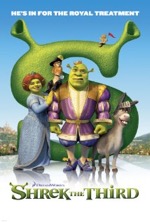
Starring: Mike Myers
May 2007
“The Ogre Who Wouldn’t Be King”
There’s a scene toward the beginning of Shrek the Third where the not-so-jolly green ogre grabs a wine bottle and tosses it against the stern of a departing ship; to honor the long-standing, sea-faring tradition of christening a ship on its maiden voyage. The force of his throw, however, shatters a section the wooden hull and water immediately begins flooding the lower decks of the ship. In a matter of seconds the vessel is completely submerged, leaving nothing but bubble streams rising to the surface and stunned expressions on the faces of those gathered to see the ship off.
The scene is a microcosm of the perils facing this movie in particular and the series in general. With the arrival of the third Shrek film, it has become painfully obvious that the ship is sinking…rapidly.
All of the familiar voices are back: Mike Myers as Shrek, Cameron Diaz as Fiona, Eddie Murphy as Donkey, Antonio Banderas as Puss in Boots, Rupert Everett as Prince Charming, John Cleese as King Harold and Julie Andrews as Queen Lillian. The latest legendary figure to be added to Shrek’s mythical mélange is King Arthur (are you ready for this…Justin Timberlake), who’s painted here as an ungainly, wussy-boy named Artie. Artie is reticent to assume the title and responsibilities of being king, a role that is being forcefully foisted upon him by the true heir to the throne, Shrek.
Does anyone else find this kind of revisionist history hard to swallow, or outright offensive? Riddled by other such discrepancies and inanities, the movie’s plot would make a nursery rhyme read like Shakespeare. Besides the aimless storyline, recycled gags, Dick and Jane dialogue and snail-like pacing, the movie fails to entertain because the once-charming premise of fairy tale potpourri has grown so tired that Rumpelstiltskin would be considered an insomniac by comparison.
It’s clear that Shrek’s producers are content to milk the cash cow for as long as they can—in other words, for as long as we keep feeding it the green. So I say, let’s boycott future Shrek films (number four is already in the works), until the powers that be bring back the fun-filled frivolity that first made us fall in love with the magical, whimsical land Far, Far Away and its colorful characters. That may seem a bit extreme, but the alternative is to sit back and hope that Shrek the Fourth is better than Shrek the Third; a brand of wishful thinking that borders on the naive.
Some have defined insanity as doing the same thing over and over again while expecting a different result. If that statement is anywhere close to being true, the Shrek series is already well on its way to the funny farm.
Rating: 1 1/2
Spider-Man 3 (PG-13)

Starring: Tobey Maguire
May 2007
“Could This Be the End of Spider-Man?”
Just as Superman has his kryptonite, comic-to-movie adaptations have their own inherent vulnerabilities. The bane of most superhero flicks is the seemingly irresistible temptation to cram an entire rogue’s gallery into one movie. The Batman films of the 90’s were notorious for packing in the villains, and the X-Men trilogy nearly collapsed under its own weight when new heroes and villains were added to each successive chapter. Armed with that knowledge, you’d think the creative forces behind the mega-blockbuster Spider-Man films would avoid such a narrative pitfall. Think again!
After loosing the initial skirmish to the belligerent behemoth dubbed Sandman, Spider-Man rhetorically questions, “Where do all these guys come from?” Good question. But a better one is, “Why do we need all these guys?”
The previous Spidey films managed just fine with only one villain apiece; the result of such narrow focus was tight story lines with engaging plots. Here we have three antagonists: Harry Osborn/Goblin (James Franco), the aforementioned Sandman/Flint Marko (Thomas Haden Church) and Eddie Brock/Venom (Topher Grace).
Harry, it seems, still has feelings for M.J. (Kirsten Dunst), and does his best to steal her from Peter/Spider-Man (Tobey Maguire). Harry hasn’t gotten over his hatred of Spider-Man for killing his father, but that quickly changes when Spider-Man puts Goblin in the hospital and a pseudo-lobotomy restores Harry to the likable guy we met in the first movie. The transformation is short lived, however; one look at his father’s creepy self-portrait is all it takes to jog Harry’s memory and rekindle his burning desire to destroy Spider-Man.
Flint is on the run from cops when he falls into a sand pit (at least it wasn’t a vat of acid). The pit is actually part of a science experiment that, when activated, turns Flint into Sandman. The presumably top-secret experiment—which is located in the middle of an abandoned field and comes to life only after Flint falls into the pit—takes random happenstance to absurd limits. Other than his little daughter’s terminal illness and his fugitive status, we learn very little about the granulated criminal. Flint’s statement, “I’m not a bad person…I just have bad luck,” was clearly intended to generate sympathy from the audience, but since Flint’s character development is as porous and insubstantial as his alter ego, we really could care less about him or his luck.
Eddie is more of a nuisance than a serious threat until later in the film when the extraterrestrial Venom (whose origin is never adequately explained) takes possession of him. When it comes to strength and ability, Venom and Spidey seem evenly matched and, as such, an exclusive fight between the pair would have been much more satisfying and engrossing than the film’s climactic battle royale; the dizzying whirlwind of activity that surrounds the four combatants weakens the impact of the melee and detracts from audience enjoyment.
While on the subject, S3’s action sequences—across the board—aren’t nearly as good as the ones showcased in the earlier films and fail to generate anything that even remotely resembles edge-of-your-seat exhilaration. Pre-release, producer Avi Arad promised that the subterranean subway conflict between Spidey and the Sandman would top the aboveground train sequence from the second movie (Premier Jan/Feb 07). In what way? Certainly not in length, intensity or creativity! The biggest problem with S3’s action scenes? They lack emotion. Nobody seems to be in any real danger; not even M.J., who for the umpteenth time is left hanging from a precipitous height—here she dangles alongside newcomer, Gwen Stacy (Bryce Dallas Howard, who doubles as the new love interest for Peter and the movie’s most disposable character). The only fracas that has any originality is the final showdown between Spidey and Venom—the visually stimulating sequence is based on sound scientific principles.
Other than a few new faces and places, not much has changed since S2: M.J. is still a struggling actress; Peter still attends college, still drives a moped, still lives in the same ramshackle apartment and still can’t get things right with M.J. This lack of progression severely hamstrings the story. Not only is the movie formulaic, it’s also pedantic; S3 backtracks through familiar territory in a manner reminiscent of the thoroughly disappointing Return of the Jedi—also the third film in a trilogy that egregiously rehashed story elements from earlier films in order to fill out the movie.
Of all the things that went wrong in S3, and there are many, the biggest creative culprit is the tepid screenplay written by Ivan Raimi and S2 scribes, Sam Raimi and Alvin Sargent. The regression in script quality from S2 to S3 is truly staggering; not only is the dialogue hokier than normal, but the plot, for all of the reasons stated above, suffers from a debilitating form of sequelitis.
Spoiler Warning: There are two glaring defects in the script which stand out like a flashlight in a pitch-black cave; one involves revisionist history and the other employs an insidious strain of deus ex machina. Uncle Ben’s killer wasn’t the man in the car (as was originally presumed), but Flint, who allegedly fired the gun on accident. Okay! Even Peter is incredulous and furious when he learns about the “new evidence.” This not-so-minor alteration—necessary for fleshing out Flint’s background and providing Spidey with a motive for confronting Sandman—simultaneously disrupts the continuity established in the earlier films and destroys S3’s credibility.
Even worse is the storyline involving butler Bernard’s (John Paxton, who’s delivered maybe two lines in as many movies) perfectly timed admission to Harry that Harry’s father, Norman (Willem Dafoe), absolved Peter of killing him before he took his final breath. So why does the tightly guarded secret surface at this precise moment? The butler’s had nearly two movies to make such a confession. Ah, could it be that the script requires the convenient disclosure at this exact moment so that Harry can have a change of heart and aid Spidey in fending off Sandman and Venom? The answer to that question can be found in Spider-Man’s recruitment speech to Harry, “I can’t take them both.” Of course he can…he’s Spider-Man! Since when did Spidey become so spineless? Since when did Raimi use plot contrivances to service his scripts?
I seldom get nauseous while watching a movie (unless I’ve put too much butter on my popcorn), but the faux breaking news segments during the climactic battle work like mental ipecac. The melodramatic exclusives of Spidey in danger (i.e., “Could this be the end of Spider-Man?”) are so mind-numbingly inane they nearly defy description. Like the obnoxious beeping of an alarm clock in the midst of a pleasant dream, these scenes rudely jolt spectators out of the movie’s comfortable, highly styled fantasy world and into present reality…which they paid ten bucks to escape. The resultant disorientation, intensified here by the use of real-life news reporters, makes for a very unpleasant viewing experience. These scenes are feeble attempts at paying tribute to Spider-Man’s earlier incarnations in comic book and cartoon form; feeble because they come off as a cutesy gimmick instead of a sincere homage.
The only subplot that lives up to its potential is Peter’s dark descent into the depths of his own ego, instigated by his newfound celebrity among the general public and his new ability-enhancing, personality-altering black outfit which is composed of Venom’s sinister tendrils. The old Proverb cautions that “Pride goes before the fall.” Peter quickly eschews such instruction when adulation from his fans takes him on a heady trip at a parade thrown in his honor. “They love me,” he gleefully comments to himself. But soon enough, his arrogance and self-absorption alienates his friends and family, and by the time Peter realizes the severity of the wicked acts he’s committed and the manner in which Venom has poisoned everyone and everything in his life, it’s nearly too late. These scenes, though far too few, are powerfully poignant and serve as the emotional backbone for a story in desperate need of one.
Still, the movie does have some redeeming qualities: Bruce Campbell lends the film some much needed levity in his performance as the maitre d’ at the exclusive restaurant where Peter clumsily botches his proposal to MJ. Campbell, who’s appeared in every Spider-Man film to date, is uproariously funny in the scene. J.K. Simmons reprises his role as the choleric newspaper editor, J. Jonah Jameson, but the whole anger management angle stifles the character’s fun and effectiveness. If a Spider-Man 4 is in the offing, let’s hope Jameson reverts back to his irascible, yet more lovable, self.
In the end, Spider-Man 3 tries to accomplish too much and, like our hero, buckles under the weight of its own ambition. The acting and directing are unassailable, but the story gets bogged down by too many subplots; the writers should have streamlined the narrative by jettisoning one or two of the villains. I won’t argue that Spider-Man 3, though a little too dark at times, is a great popcorn movie; but the price of popcorn is higher these days and so are my expectations for sequels to successful series. So, will there be a Spider-Man 4? If it takes after the first two movies, I say, bring it on. If not, let’s just cut our losses and deem Spider-Man a landmark trilogy with a lackluster finale.
Rating: 2 1/2
Lucky You (PG-13)
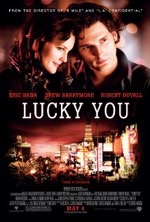
Starring: Eric Bana
May 2007
“Bana and Barrymore Are a Winning Pair”
Movies that try to create an epoxy out of disparate story elements (like Treasure Planet’s pirates in space conceit) typically fail to bond either because the elements aren’t complimentary or because spectators would enjoy seeing a film about one or the other, but not both together. In Lucky You, director Curtis Hanson—along with a star-studded cast including Eric Bana, Drew Barrymore, Robert Duvall and Debra Messing—has defied the odds with his surprisingly robust romantic drama that revolves around poker.
Huck Cheaver (Bana) is a fast-living, thrill-seeking poker addict, who lives life on the edge and lets the chips fall where they may. Estranged from his father, L.C. (Duvall), Huck has refined the art of smooth-talking, especially with women, but his lack of commitment coupled with his gambling habit has relegated him to a life of loneliness in his Spartan house, which boasts a high-end entertainment system but has less furniture than a motel room.
The movie’s romantic leads first meet when Huck rescues Billie (Barrymore) from a sleazy schmoozer. Huck soon learns that Billie is the younger sister of one of his acquaintances, Suzanne (Messing). Despite Suzanne’s warnings, Billie becomes involved with Huck, but it doesn’t take her long to discover Huck’s score: Hustle = 10, Commitment = 0. As someone who doesn’t fall for his patented spiel, Billie challenges Huck with, “You say whatever you want people to hear.” As Huck’s feelings for Billie intensify, he finds himself at a crossroads; his budding relationship now stands in direct opposition to his dream of competing in the World Series of Poker.
For some, Lucky You will feel like a feature-length version of a TV poker tournament; others will see the film as an extended seminar on the finer points of Texas Hold ‘Em poker. However, there’s more here than just a high-stakes card game. The movie is extremely instructional at revealing the gambler’s mentality: the competition and compulsion that compels the gambler to risk it all on a bet (one of Huck’s male acquaintances looses a wager and is made to walk around with false breasts).
Bana and Duvall are a very good father and son pairing and have excellent chemistry—L.C. is a two-time W.S.P. champion and Huck has lived his life in the shadow of his father’s accomplishments—the friction between the two is nearly palpable. There’s an excellent scene where L.C. shows up at the café where Huck and Billie are having breakfast. Billie, feeling awkward about the unexpected intrusion, excuses herself to make a phone call. Father and son engage in a war of words as they play a fast-paced variation of poker. Besides the action onscreen, what makes the scene crackle with intensity is the knowledge that Billie will soon return and find them playing poker. When Billie does return, her reaction—which ranges somewhere between shock and revulsion—reveals the perspective of an outsider who, for the first time, sees the mental illness that inflicts those with a gambling habit.
Duvall, like fine wine, continues improving with age—his performance here is easily the most textured and intricate in the film. Bana and Barrymore are a feasible couple and both shine in their respective roles. Though Barrymore is the beneficiary of some fine dialogue, written by Eric Roth and Hanson, she still holds her own in a role more demanding than her usual teeny-bopper fare. Parts like this just might make a serious actress out of her…time will tell.
The biggest challenge the movie faces is timing, which on the face of it sounds ignorant since timing is crucial to every movie. Texas Hold Em’ reached the height of its popularity, at least on TV, about two years ago. Had the movie been released at that time—or even six months ago so that it could cash in on some of Casino Royale’s success—Lucky You may have stood a better chance of winning big. As things are, Lucky You is a solid hand that plays up to its potential, but unfortunately doesn’t get the best of it.
Rating: 3
Meet the Robinsons (G)
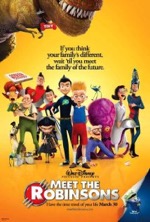
Starring: Daniel Hansen
March 2007
“Light-years Ahead of Other Animated Family Films”
The latest animated offering from Walt Disney Studios, Meet the Robinsons, presents a story of friendship, courage and the importance of family. Directed and co-written by Stephen J. Anderson (who also provides three voices in the movie), this time travel tale, based on William Joyce’s children’s book, A Day with Wilbur Robinson, features the vocal talents of Angela Bassett, Adam West and Tom Selleck.
As an infant, Lewis was abandoned by his mother on the doorstep of an orphanage…now a precocious twelve-year-old, Lewis just wants to know what it’s like to have a family. A science geek by nature, Lewis makes a memory scanner out of a toaster, a safari hat, rubber bands and anything else he can get his hands on—MacGyver should be so lucky!
Unfortunately, it’s Lewis’ inventions that have sabotaged all 124 of his adoption interviews. Seizing the opportunity to display his work to prospective parents, Lewis proudly shows off his contraptions…which always seem to malfunction in spectacular fashion, sending everyone in the room ducking for cover and leaving Lewis feeling unworthy and unwanted. Lewis’ adoption agent tries to pep him up, pointing out his brilliant future as an inventor. Disheartened by constant rejection, Lewis replies, “I have no future. Even my mom didn’t want me.” Just when Lewis abandons all hope of being adopted, he makes the acquaintance of Wilbur Robinson—a self-professed “time cop”—at his school’s science fair. Wilbur shoves Lewis into his invisible time car and the two boys soon embark on an amazing journey into the future, where Lewis meets Wilbur’s eccentric, freethinking family and encounters the evil Bowler Hat Guy.
Though the first half is slow to develop, there’s just enough action in the movie—like the savage T-Rex attack—to keep most kids actively engaged. However, evaluating the movie from a kid’s perspective reveals a few potential areas of concern for parents. The evil Bowler Hat Guy is pretty silly throughout the movie, but without warning and at random times, he transforms into a darker, more sinister figure. The lanky antagonist often speaks of crushing Lewis’ dreams and ruining his life, but the biggest red flag comes when the villain admonishes Lewis’ roommate to let his anger fester and to “let hate be your ally.” Though the statement is later redeemed, the nuance of the scene may be lost on many younger viewers, some of whom might take the statement as permission to act upon what they’ve heard. There’s also an alternate future which paints dark images of a world overrun by electronic hats with spider-like appendages; an adolescent rendering of The Terminator’s Skylab, the scene may be too frightening for younger kids.
On balance, the movie reinforces such virtues as working hard and pursuing a dream, and contains more than just a few heartwarming moments. Many of the Robinson’s mannerisms seem strange to Lewis, but he finds their kindness, encouragement and non-judgmental approach to life to be a welcomed change to his rigidly regulated existence at the orphanage. When another of Lewis’ inventions goes haywire in the future, the entire Robinson family celebrates his blunder; “From failing, you learn!” they excitedly exclaim. Such unconditional acceptance prompts Lewis’ statement, “If I had a family I would want them to be just like you.”
Despite a few minor defects, Meet the Robinsons is a valiant attempt at restoring Disney animation to its former glory while ushering in a bold, new era of high-quality CGI films. The movie concludes with an inspirational quote from Uncle Walt himself, “Keep moving forward!” There have been some flops over the years, but I’m sure Walt would agree that Meet the Robinsons is a step in the right direction.
Rating: 3
Wild Hogs (PG-13)
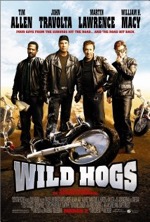
Starring: Tim Allen
March 2007
“Sits in Idle Waiting for a Story to Show Up”
Something happens to a man when he wakes up one day and realizes his face is starting to show wrinkles, his hair is beginning to turn gray or loose and gravity is doing a number on his belly, transforming the once glamorous six-pack into a keg. It suddenly dawns on him that there are fewer days ahead than behind and that there’s a long list of things he still wants to accomplish in his lifetime. Invariably, one item on the list is a cross-country trip on a Harley.
And so we have Wild Hogs; a comedy (and I use that word loosely) about four middle-aged men seeking thrills and excitement outside their ordinary lives and dead-end jobs. Doug (Tim Allen), Woody (John Travolta), Dudley (William H. Macy) and Bobby (Martin Lawrence) don motorcycle gear, throw away their cell phones and set off on a journey of self-discovery and male bonding. The road trip starts off rather aimless, but quickly gains focus and immediacy when the four amigos stop off at a bar infested with members of a notorious biker gang known as the Del Fuegos. The balance of the movie focuses on the Wild Hogs’ cowardly attempts at evading the Del Fuegos, but at the appointed time the Hogs develop a collective backbone and stand up to the antagonizing gang, thus satisfying their jones for adventure and fulfilling the story’s promise that the four men will be revitalized as a result of their two-wheel trek.
Wild Hogs was made-to-order for Allen, but Travolta’s participation, and to a greater extent, Macy’s, is a bit of a head-scratcher. The leads are appropriately automatic, if excessively melodramatic, and there are some solid supporting performances turned in by Ray Liotta, Marisa Tomei and Peter Fonda. Liotta’s portrayal of the spitting-mad leader of the Del Fuegos is the standout performance in the film, which is pretty sad when you think about it.
Wild Hogs is an abhorrent film with a paper-thin plot and over-the-top performances that squander the talents of the high profile cast. The movie is neither humorous nor insightful and is an egregious waste of time. Written by Brad Copeland, the story consistently defaults to the silly and absurd, which is a shame since the topic of a mid-life crisis could have retained elements of comedy while offering more depth and meaning in the script department.
Anyone who’s frustrated when art films languish while mediocre fluff wins big at the box office will be driven to the brink of insanity by Wild Hogs. The movie is essentially The Wild One or Easy Rider written by a middle school student.
Rating: 1 1/2
Amazing Grace (PG)

Starring: Ioan Gruffudd
February 2007
“Inspiring and Moving, but Not Quite Amazing”
You would naturally think that a movie named after the venerated church hymn would feature the song’s writer, John Newton, but, as Miracle Max from The Princess Bride would say, you’d only be “mostly” correct. Though Newton does appear in the film in a minor role (Albert Finney plays the blind composer with the appropriate degree of nobility and sagacity), the movie’s main character is William Wilberforce (Ioan Gruffudd, Reed Richards from Fantastic Four), an idealist championing social reform in Britain circa 1797. While fighting for the abolition of slavery, Wilberforce also contends with a debilitating illness which ultimately claims his life.
There are a number of memorable scenes in the film, but two standout moments reveal the ways in which good can overcome evil, even when using less than virtuous methods (See: Star Trek’s “The Savage Curtain”). The first instance of righteous chicanery occurs near the middle of the movie when Wilberforce instigates a poignant object lesson under the guise of an extravagant lunch served aboard a sailing ship drifting along one of London’s channels. Wilberforce tricks the assembled members of high society into experiencing, firsthand, the plight of African slaves when the elaborate vessel pulls alongside a slave ship. The inhuman conditions that exist on such ships, which have produced what Wilberforce terms the “smell of death,” confront the affluent onlookers with a graphic tableau of how the other half lives. There’s a bit of populist pride that creeps in when Wilberforce demands the wealthy spectators to lower the handkerchiefs from their noses and deeply inhale the fetid aroma. It’s a brief sequence that makes an indelible impression on the memory.
The other episode of legerdemain takes place near the end of the movie when Wilberforce tries pushing though legislation that will abolish the country’s slave trade policies. The strategy he uses to manipulate Parliament into getting the motion passed is a stroke of genius…it’s the stand and cheer moment of the movie. Even though his stunt is highly deceptive, the cause is just: Wilberforce’s tactics surely would’ve met with approval by the great emancipator himself, Abraham Lincoln. Hopefully, as a result of viewing this film, many will now esteem Wilberforce as the slavery abolitionist from over the pond.
Although it’s quite obvious from the outset that the film isn’t a big budget extravaganza, director Michael Apted (Nell) does an excellent job of maximizing what little star power and budget he has at his disposal in crafting this inspirational tale of Wilberforce’s unwavering courage and conviction in the face of unspeakable evil. Apted also effectively capitalizes on the strength of the exceptional supporting cast: Michael Gambon, Ciaran Hinds, Rufus Sewell and Toby Jones are all well-known and well respected British actors who perform their respective roles with the requisite degree of competence and brilliance. Aside from the cast, the bulk of the film’s meager budget was allocated for location shooting and period appropriate sets and costumes, and though the results have a decidedly Hallmark look to them at times, the overall production is bolstered by the film’s fine performances, an engaging narrative and Apted’s sure-handed direction.
With another marvelous performance turned in by Gruffudd, I guess we now must consider which superlative will accompany the title of his next project. After all, his most recent films have been fantastic and amazing. Regardless of what his next movie is named, I’m sure it’ll be stupendous.
Rating: 3
Bridge to Terabithia (PG)

Starring: Josh Hutcherson
February 2007
“The Best Family Fantasy Film This Side of Narnia”
This is one of those extremely rare instances where the movie is actually better than the book. Bridge to Terabithia, the John Newberry Medal-winning children’s novel by Katherine Paterson, which tells the story of two pre-teens that forge an unlikely friendship and discover an enchanted realm in the forest just behind their neighboring houses, has been brought to magical life by Walt Disney Pictures and Walden Media.
In C.S. Lewis’ The Lion, the Witch and the Wardrobe (also produced by Walden), the magical land of Narnia is accessed by walking though a long-abandoned wardrobe; here the children enter the imaginary realm of Terabithia by swinging across a gully into a dense forest. The main difference between Narnia and Terabithia (which may have derived its name from Lewis’ island of Terebinthia in The Voyage of the “Dawn Treader”) is that Narnia is a fully realized magical land, while Terabithia is wholly imagined by Jess Aarons (Josh Hutcherson) and Leslie Burke (AnnaSophia Robb).
Jess, a budding artist, dreams about being the fastest kid in the sixth grade. Leslie, the new girl in school, has her free-thinking, book writing parents to thank for her overactive imagination. Despite a mild setback when Leslie outpaces Jess in a race and embarrasses him in front of his entire class, the two become fast friends. When Leslie conjures up the magical kingdom in a nearby wood, Jess sketches it on paper and the world of Terabitha begins to take shape. (Paterson’s tale of two prepubescent friends forging an imaginary world deeply resonates with me: I had similar experiences growing up, but most of my adventures with friend, Dan, took place in the various mainstream sci-fi universes of the late 70’s and early 80’s at a variety of locations around town.)
As was mentioned earlier, the movie surpasses the book in a few key areas: First, there are several logical extensions of scenes or new tidbits of character development that serve as embellishments to Paterson’s original text. One example is the scene where Jess, having worn holes in his own sneakers, takes a black marker to his sister’s old, pink tennis shoes to make them passably respectable for the race at school. Unfortunately, the marker wears off by the time the recess bell rings and Jess has to run the race in pink sneakers. The second area where improvements were made is in the area of visual effects. In Paterson’s story, Terabithia is frequently referenced and visited by the children, but the enchanted land is never fleshed out in any detail. Now, thanks to the vision of director Gabor Csupo and the innovative wizardry of those at Weta Digital, Terabithia has come to life in a breathtaking ways, specifically with the addition of a tree house fortress, skrogers (squirrel ogres), dragonfly warriors, swooping eagles, a giant troll and a jaw-dropping celebration sequence where the various denizens of the kingdom assemble to applaud the arrival of the new princess.
The third element that sets the movie apart is the excellent actors that breathe life into their respective characters: Hutcherson and Robb are joined by Robert Patrick as Jess’ dad and Zooey Deschanel as the kids’ music teacher, Ms. Edmonds. Each member of the cast does an excellent job, but it’s really Robb’s winsome performance that steals the show. Robb is a genuine cinematic treasure and one can only hope she doesn’t turn into the next Lindsey Lohan.
Even though Bridge to Terabithia will find itself comfortably perched atop family film top ten lists for some time to come, many will feel shortchanged by a tween-aged drama that merely flirts with fantasy rather than fully immersing itself in a mythical world, like in the case of Narnia. Others will criticize the movie for its thematic similarities to The Yearling and My Girl. Even so, the movie is highly entertaining, and for many, Bridge to Terabithia will serve as a portal to a simpler, more whimsical period in life when swinging with your head back really did feel like flying. In this age of perpetual busyness we could all learn to slow down, take a deep breath and follow Leslie’s RX for happiness, “Close your eyes, but keep your mind wide open.”
Rating: 2 1/2
Breach (PG-13)

Starring: Chris Cooper
February 2007
“Cooper is Mesmerizing in Political Potboiler”
Based on the gripping true story of how the worst traitor in the history of U.S. Intelligence was discovered and brought to justice, Breach is a fascinating post-Cold War yarn which underlines the unsettling notion that the last person you’d suspect of being a criminal often times is.
FBI agent, Robert Hanssen (Chris Cooper) has projected such a sanitary image of himself throughout his distinguished career that he’s been placed in charge of a special task force to ferret out a rogue agent who’s been selling secrets to the Russians. A devout Catholic and family man, Robert never drinks (even off duty) and frequently extols the virtues of prayer. But Mr. Clean, it turns out, has some dark secrets which are eventually unearthed by Agent Burroughs (Laura Linney). Burroughs “promotes” Robert to a new post and assigns callow agent, Eric O’Neil (Ryan Phillippe), to serve as Robert’s assistant and her informant. As the high stakes chess match plays out, the questions become: is Robert guilty of treason, and if so, is anyone clever enough to beat him at his own game?
Breach, even without car chases and shootouts, is a first-rate potboiler that contains enough intrigue to fill two movies—the PDA download and car sweep scenes are especially suspenseful. Director Billy Ray does an excellent job of gradually building intensity throughout the film, and the script by Adam Mazer and William Rotko doesn’t miss a beat. The movie’s incisive dialogue is finely crafted and contains several memorable gems, like Robert’s first line to Eric, “Tell me five things about yourself and four of them true.”
Cooper turns in a spellbinding performance as Hanssen and almost single-handedly carries the movie: when it comes to chewing scenery, Cooper could give Pac Man a run for his money. Cooper’s wonderfully nuanced portrayal of straight-laced, no-nonsense, yet privately perverted Hanssen (the scene where he lusts after Entrapment’s Catherine Zeta-Jones is downright disturbing), is utterly captivating and convincing. An Oscar nod would be the appropriate response to this powerhouse performance.
Though some have exiguous onscreen time, the supporting actors play a vital role in servicing the plot as they fall into orbit around Cooper: Linney and Phillippe are joined by Caroline Dhavernas as Eric’s wife, Kathleen Quinlan as Robert’s wife, Bruce Davison as Eric’s father, Gary Cole as Agent Garces and 24’s Dennis Haysbert as Agent Plesac.
Besides touting the acting, directing and writing, there’s little more that can be said here without spoiling the plot to this truly riveting tale; a story that’s made all the more alarming by its factual elements. As the shock and horror of 9/11 continues to fade from our collective consciousness, Breach is a jarring reminder of the ever-increasing need for intelligence and vigilance…lest we should forget the tragedies of the past.
Rating: 3
Music and Lyrics (PG-13)
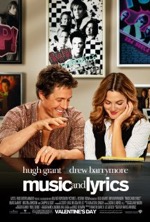
Starring: Hugh Grant
February 2007
“Romantic Melody with Dramatic Harmony”
Prosody. It’s a word music producers toss around that refers to the perfect marriage between lyrics and music. The characters in writer/director Marc Lawrence’s new film, Music and Lyrics, desperately search for prosody, both musically and relationally, and find a rare blend of artistry and intimacy over and under the piano.
Alex Fletcher (Hugh Grant), the former lead singer of the mullet-coifed 80’s group, Pop, has been commissioned to write a song for Cora (Haley Bennett), the newest sensation in pop music (think Britney but more seductive…if that’s possible). Cora gives Alex the hook line and tells him to deliver the song by Friday; Alex clears his schedule, gladly canceling a guest spot on the TV series, “Battle of the 80’s Has-beens.” Alex, who has no skill at writing lyrics, calls upon one of the industry’s finest lyricists to bail him out; but when it becomes painfully obvious that the partnership isn’t working, Alex turns to the substitute plant lady, Sophie (Drew Barrymore), who absentmindedly raps off some lines that perfectly fit the song while watering the petunias.
Alex and Sophie immediately hit it off and even though you can divine early on where the story is headed, credit Lawrence with making Alex and Sophie’s lovelorn journey a bumpy and unconventional one. In fact, the most enjoyable aspect of the movie is that the romantic interludes take a backseat to the compelling drama, which skillfully steers the plot. Case in point: there’s an excellent scene where Sophie tells Alex her back story over breakfast in a quaint bakery—it’s one of those magical moments which, unfortunately, are seldom given the chance to develop in most modern movies where special effects, not character development, rule the day.
As joined at the hip as the music and motion picture industries are, it’s refreshing to see a movie portray the music business honestly and unapologetically. Alex’ commentary at Cora’s pre-recording party—where he bursts Sophie’s idealistic bubble—is harsh but accurate, “In the end it’s all just business.” The thinly veiled caricature of Cora as a Britney/Christina/Shakira clone is perhaps a bit exaggerated but reveals the selfish tendencies and shallow propensities of many spoiled rotten pop stars who seem to make headlines (often negative) every day. Cora’s sensual, Indian-flavored songs were clearly written as tongue-in-cheek parodies of modern hits, but how similar are they to the vast majority of uninspired, cookie-cutter tunes that dominate today’s pop charts? It’s in these brilliantly insidious scenes where the screenplay is most instructive and effective. Unfortunately, the movie’s solid setup gives way to a standard happy ending that’s sure to make women sigh in ecstasy and men groan in agony.
Barrymore is in familiar territory here, and though she’s convincing, isn’t she getting just a bit typecast with these one-size-fits-all chick flicks? Could it be that there’s more in her than lighthearted dramedies? As for Grant, he simply steals the show with his charisma, charm and quick wit; his comedic timing is impeccable and his dramatic range is also impressive. The film is also augmented by its superb supporting talent: Brad Garrett takes on the role of Alex’ overprotective agent and Kristen Johnston plays Sophie’s sister, a lifelong Pop fan who absolutely worships Alex…especially when he’s in his tight black leather pants.
Music and Lyrics is a slightly better-than-average romantic comedy that strikes all the right notes with great performances and incisive dialogue. Whether or not the movie has achieved prosody, however, is a matter of opinion—after all, art, and especially music, is anything if not subjective.
Rating: 2 1/2
Because I Said So (PG-13)
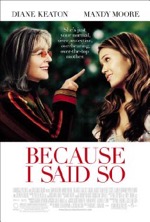
Starring: Diane Keaton
February 2007
“‘Because I Said So’ is Not Sufficient Reason to See it”
Boasting a decorated cast and an estrogen-infused screenplay, Because I Said So tells the story of a meddling mother and her three beautiful daughters; one married and two in desperate need of mom’s services as self-appointed matchmaker.
Daphne Wilder (Diane Keaton), an overbearing, overprotective divorcee, feels it incumbent upon her to find a husband for her listless and lovelorn daughter, Milly (Mandy Moore). Daphne takes a cue from MTV’s Date My Mom by interviewing prospective mates for Milly; young men who are responding to an online profile Daphne filled out for her daughter. The hapless suitors, expecting to meet Milly at an exclusive restaurant for lunch, unwittingly fall into Daphne’s web of control and are grilled about their respective careers, interests, political/ religious views, etc. As usually happens in these instances, Daphne selects someone she loves, Milly is unsure about and the audience absolutely loathes.
Lauren Graham and Piper Perabo are solid in their supporting roles as Milly’s sisters and Stephen Collins is functional as Daphne’s new beau, Joe. The acting can’t be faulted, nor can Michael Lehmann’s direction. The movie’s failure falls squarely on the shoulders of writers Karen Leigh Hopkins and Jessie Nelson, who’ve churned out one inconsequential piece of tripe here…the story is as shallow as the characters it features. When the dialogue isn’t inane, it’s filled with crude remarks and potty humor. References to reproductive organs or anything pertaining to human reproduction flow as easily from the female characters in the movie as a conversation would in a men’s locker room. Such is the movie’s degrading sense of humor, which relies on peer pressure to produce laughs because very few people would naturally chuckle at punch lines so crass and depraved. In fact, any laughter that does occur during the movie, judging from the audience I sat in, is reserved, forced or halfhearted.
Other than Milly’s wedding at the end, there’s an utter lack of progression in the film, and it’s obvious that Daphne’s supposed reformation will be short-lived. As for Keaton, her shelf-life as a leading lady may have just expired. Besides the fact that she’s starting to show her age, the normally stellar starlet steps beyond the boundaries of believability with a one-dimensional performance marked by emotional extremes in over-the-top scenes. Keaton can’t be blamed for the obnoxious character she portrays, be she can be faulted for selecting the role in the first place. If Daphne has any redeeming characteristics, they’re harder to find than a mate for Milly; especially when one considers the scenes where Daphne tails Milly on a date, views porn at home or holds up Milly’s wedding because she’s doing the horizontal mambo with Joe.
If Moore ever hopes to be taken seriously as an actress, she must resist the impulse to take the easy path and accept roles like the one she effortlessly slips into here. Of course, changing the course of her career at this point could be tantamount to steering the Titanic around an iceberg. And we all know how that ended. If she’s not extra careful, she could end up typecast…if she isn’t already?
Because I Said So is the kind of movie that gives chick flicks a bad name; it’s crude, simplistic and unsophisticated. Daphne’s erratic behavior and controlling nature are finally explained when she confesses to Milly, “I just wanted to protect you from becoming me.” I’ll protect you by issuing this warning: avoid this movie at all costs. Why? Because I said so!
Rating: 1 1/2
Freedom Writers (PG-13)

Starring: Hilary Swank
January 2007
“Standard ‘True Story’ Formula Shackles Inspirational Tale”
From MTV Films, producers of Coach Carter, comes Freedom Writers, another inner-city portrait which is also based on a true story and features Academy award winning Hilary Swank as indomitable educator, Erin Gruwell. In the wake of 1992’s Rodney King riots in L.A., Woodrow Wilson High School, while embroiled in a tumultuous integration program, was reeling from violent turf wars not dissimilar to the ones taking place outside the school’s barbwire brimmed walls. Enter into that seething cauldron of bigotry and race hatred Mrs. Gruwell, a prim and proper freshman teacher who insists on wearing a real pearl necklace while also wearing a perpetual smile. Her smile is quickly erased when a knockdown, drag out fight ensues in her inaugural class.
With the classroom doubling as a battleground, teaching is a daily struggle to survive. Mrs. Gruwell eventually connects with her students as she learns their back stories. There’s an excellent scene where Mrs. Gruwell plays the “line game” with her students. Two rows of students face each other with a dividing line between them; a step toward the line indicates that a particular question applies to an individual. Mrs. Gruwell’s worst fears are confirmed when statements like, “Step toward the line if you’ve lost a friend to gang violence,” reveal the grim reality her students face on a daily basis.
The movie is standard in many ways; besides adhering too closely to the Coach Carter template, the movie comes complete with a connect-the-dots plot and underdeveloped supporting characters, played here by Scott Glenn as Gruwell’s dotting dad and Patrick Dempsey as her neglected husband. Other inherent weaknesses in the movie are a cloying resolution and an oversimplified remedy for educational and societal ills. I’m truly glad that Gruwell’s unorthodox methods of teaching paid off for a small group of young adults, but if the movie’s writers and producers are trying to champion a cause or inspire a movement, they’re being overly idealistic, much like Gruwell on her first day as a teacher. Besides, aren’t there more remarkable true stories out there just waiting to see the (green) light of day? Is Hollywood really that devoid of original material? Are we, as a society, so starved for heroes that the story of a rookie teacher who encourages her students to write about their hang-ups in journals will not only inspire us, but also induce us to shell out ten dollars to see it?
Freedom Writers is an unremarkable human interest story that has all the salience and staying power of one of those warm-fuzzy features that air at the end of news broadcasts. For those hoping to experience a feel-good flick, Freedom Writers might seem like it’s hot off the press, but for most, the movie will read like yesterday’s news.
Rating: 2 1/2